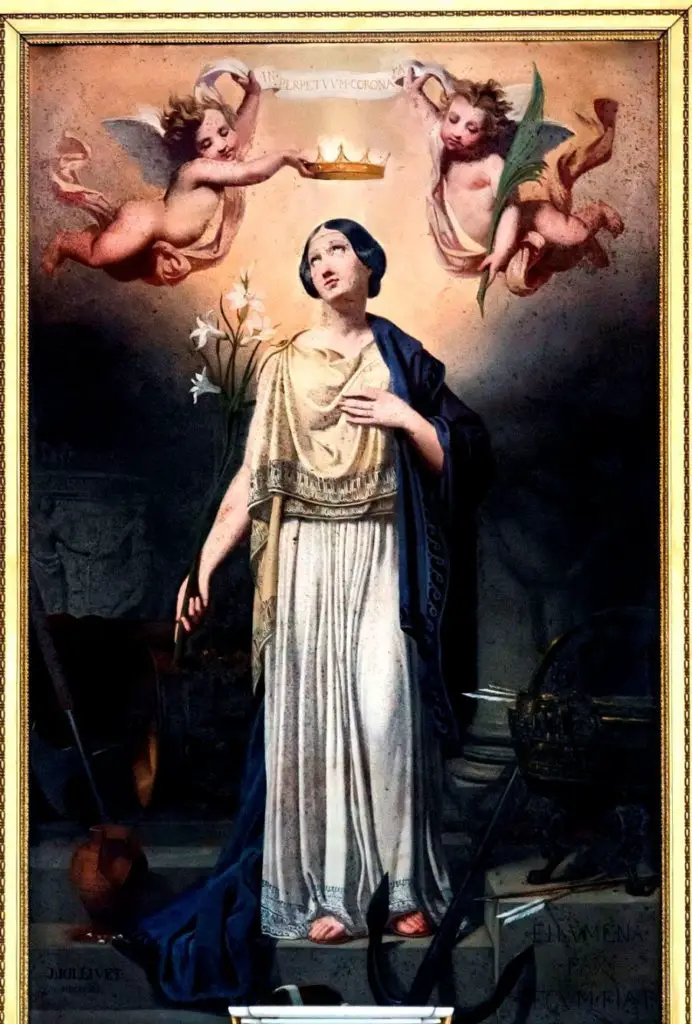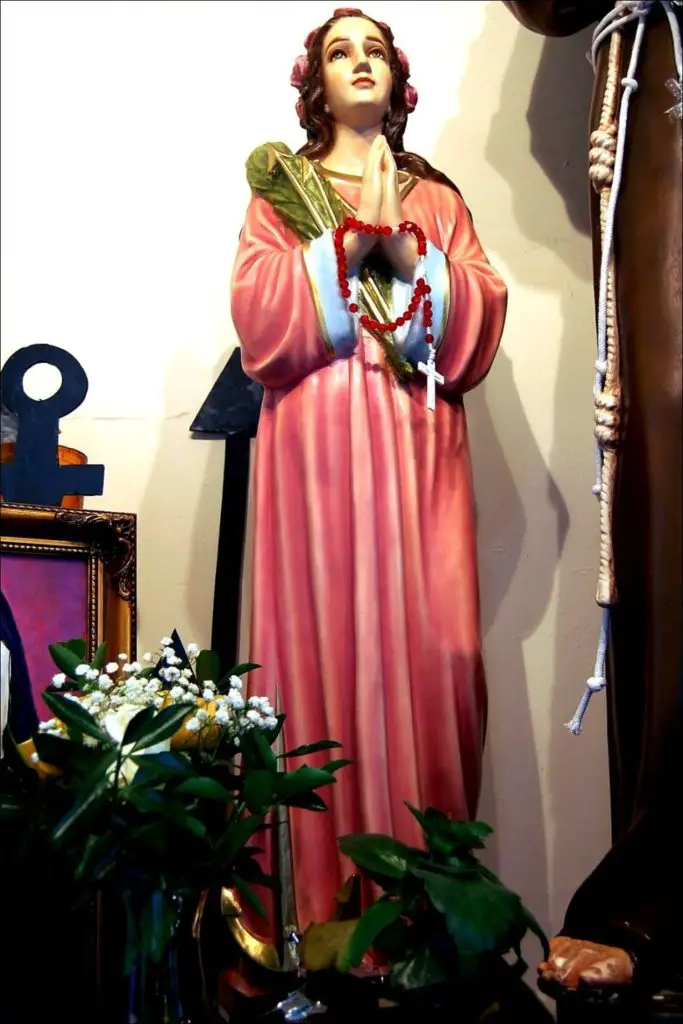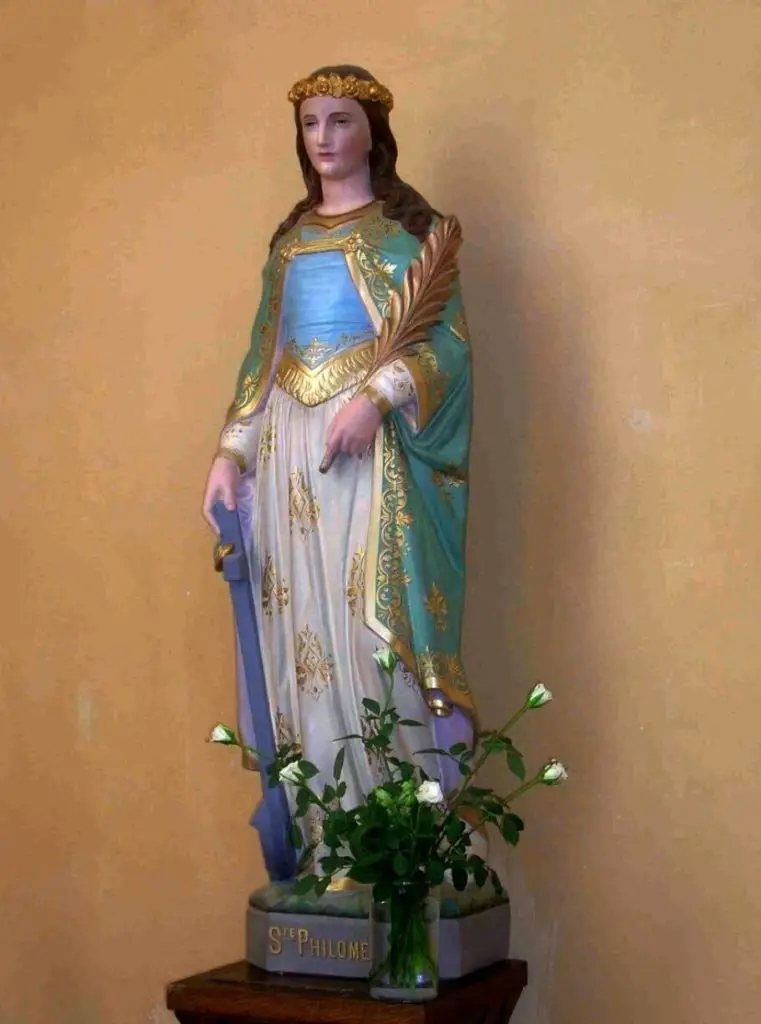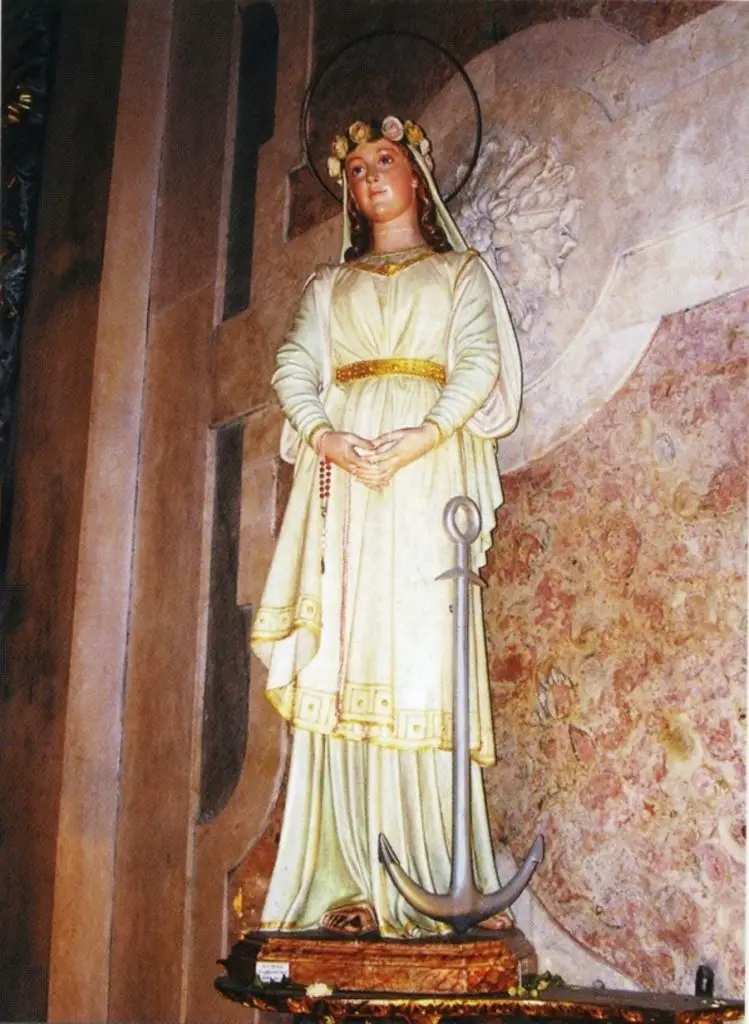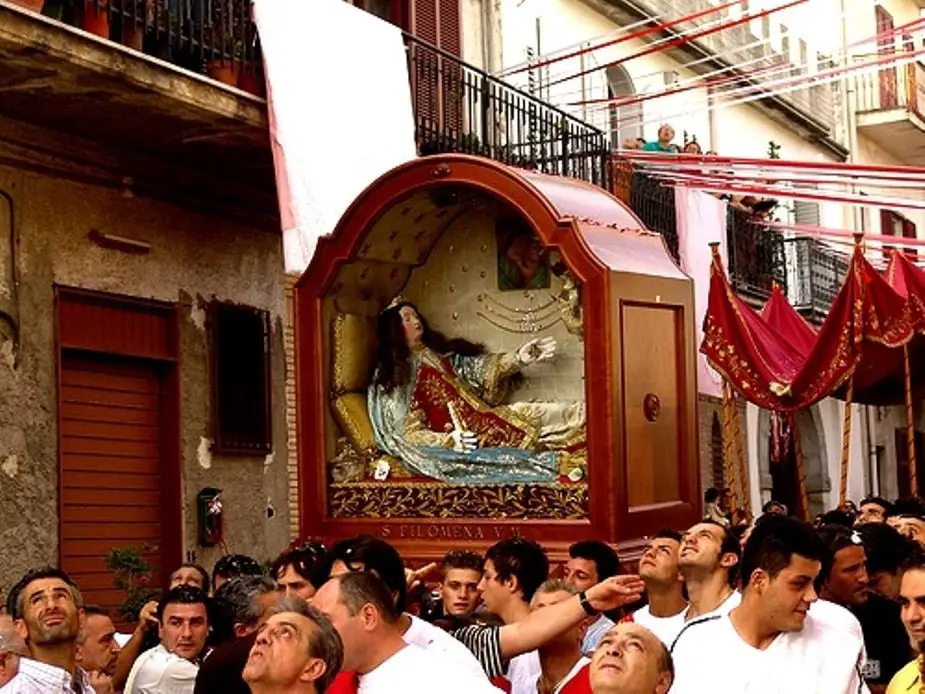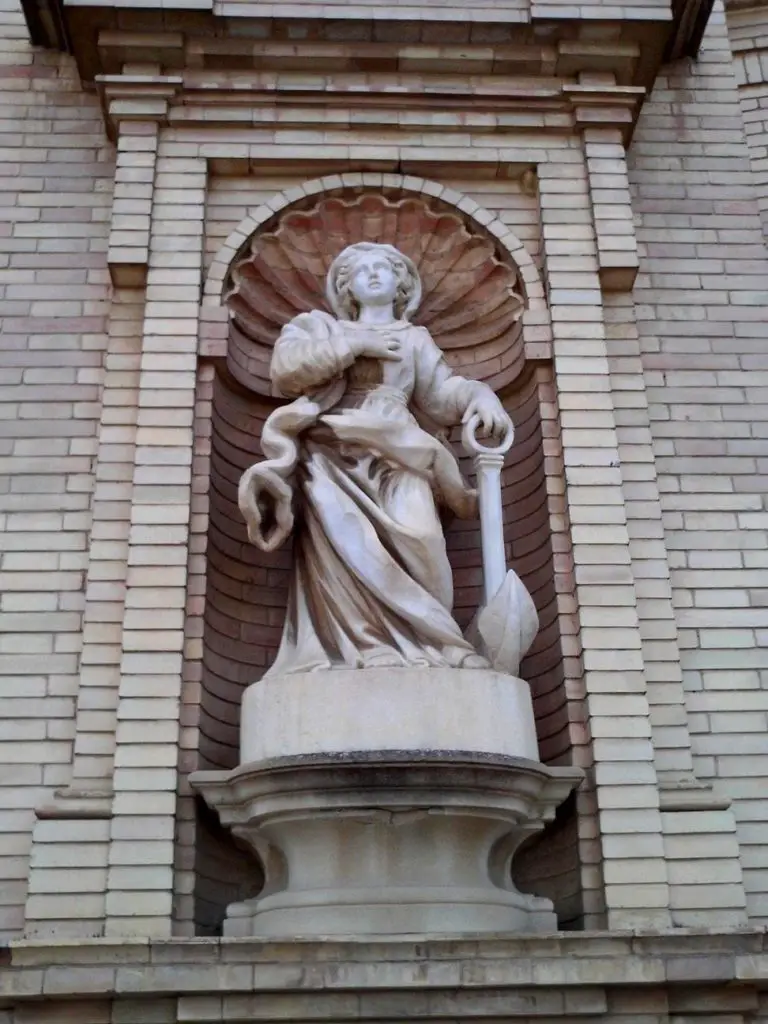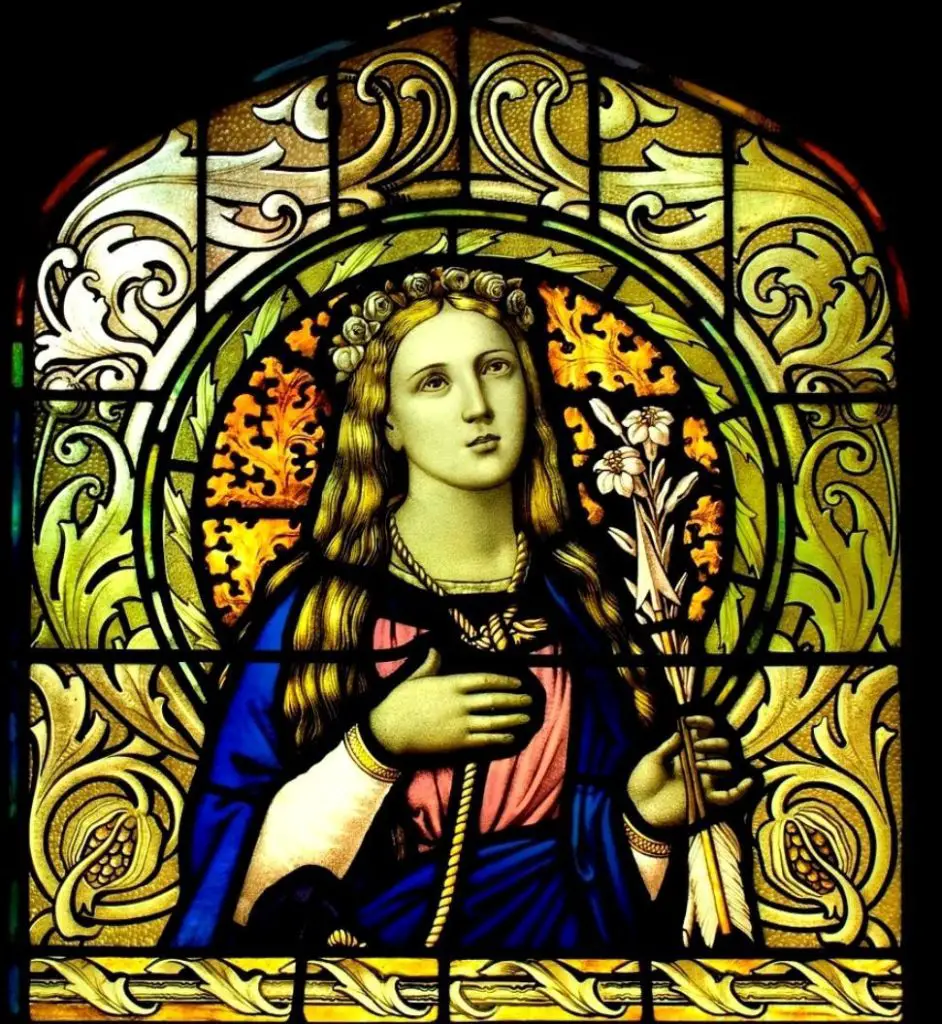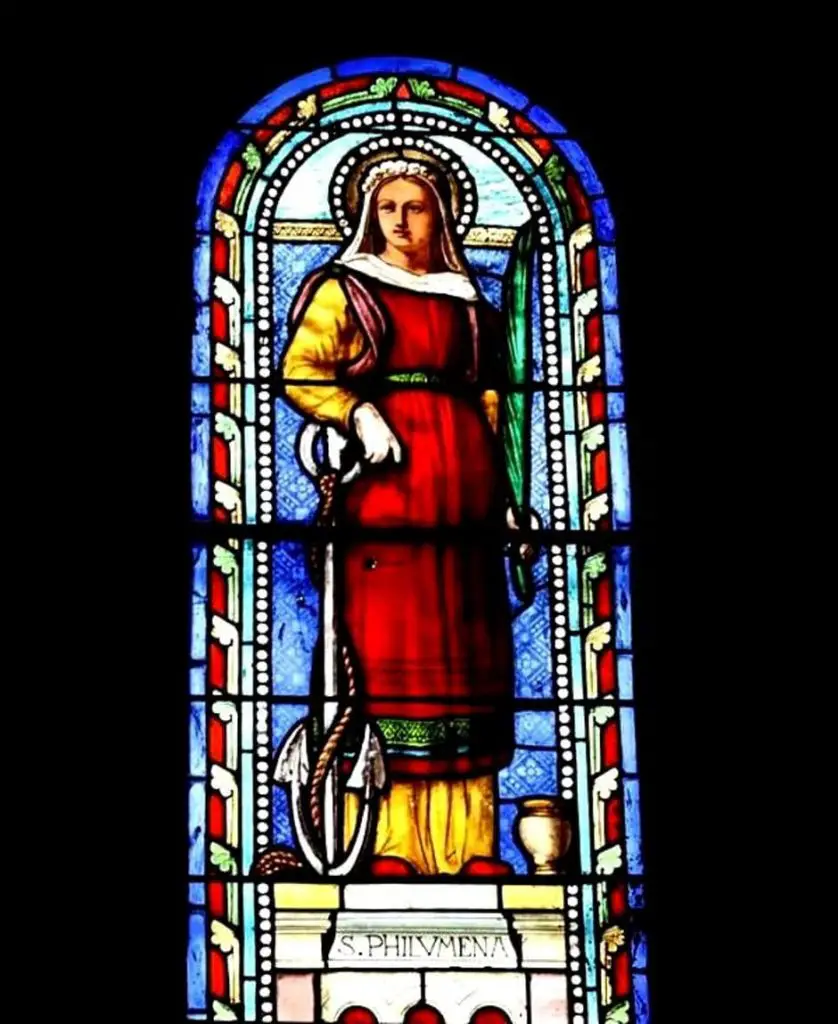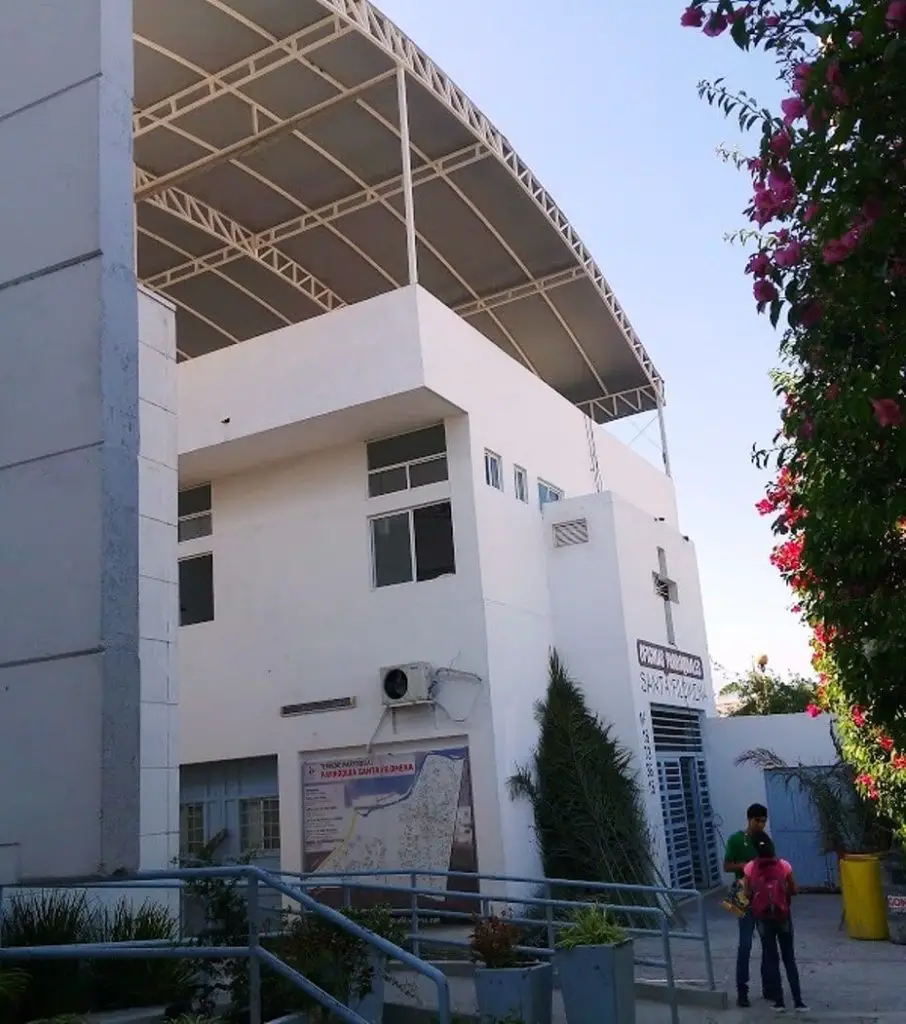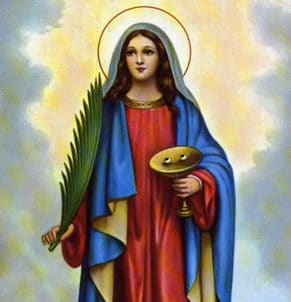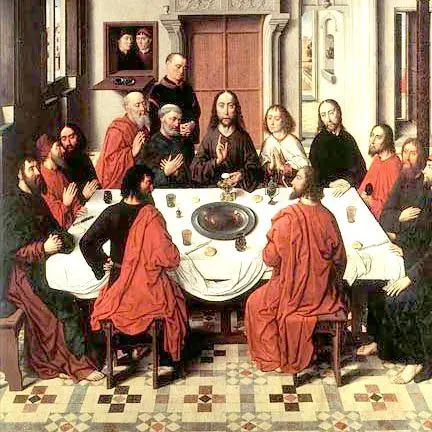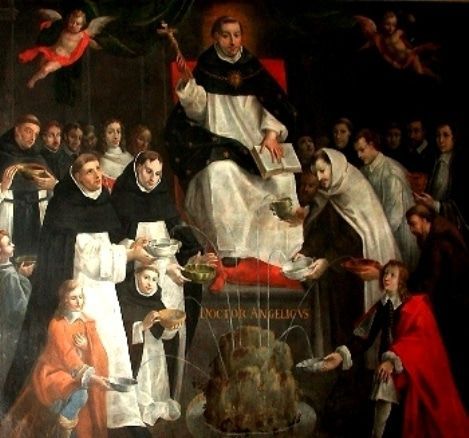Saint Philomena, know all about this young martyr, her surprising story, she is the saint who will grant you the miracle you are waiting for, learn the most effective prayers that will cure all your ills and take away your problems.
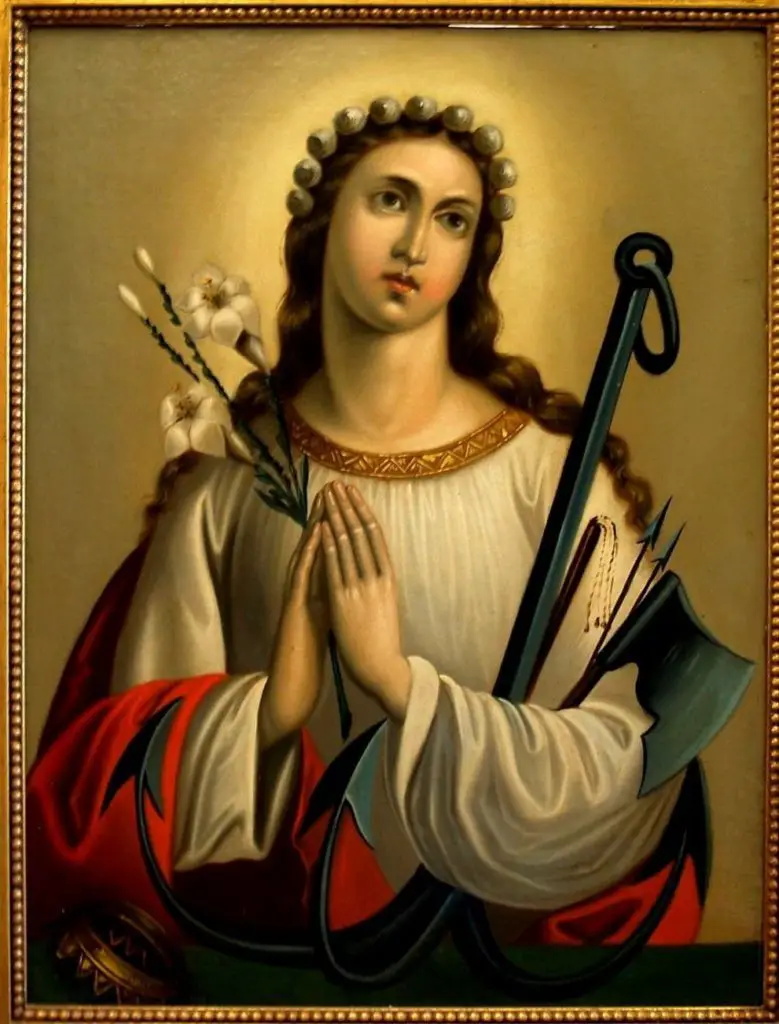
History of the martyr Saint Philomena
The story of this saint is considered a legend because the data available to verify her historical existence are summarised in a tomb containing the remains of a young adolescent girl, about twelve or thirteen years old, found in 1802 during excavations in Rome, and in the revelations given by Saint Philomena to three people who did not know each other, although they lived in Italy in the 19th century.
The revelations about the story of Saint Philomena come from three reliable sources, three people who lived between the end of the 18th century and the middle of the 19th century: an artisan from Naples, a man known to be devoted to God and to have a clear conscience; a priest, skilled in solemn ecclesiastical oratory, who became a canon; and a nun, living in the city of Naples, consecrated in soul and virginity to the work of God.
The revelations made to these three persons of good repute coincided in the details that Saint Philomena had given them, and of these three, the statements made by the nun, apparently called Maria L. de Jesus, 1799-1875, are the most extensive as regards the history of this Saint, and are those that relate the origin, the cause and the details of the martyrdom, of the short life of Saint Philomena, popularly known as the 19th century thaumaturge.
These revelations coincide with the various traces found in her crypt in 1802 in the famous catacombs of the Via Salaria in Rome, an archaic Roman cemetery. The tomb of Saint Philomena contained several elements which led her discoverers to believe that they were in the presence of a Christian martyr from the time of the persecutions against the first followers of Jesus Christ. (See the article on the persecution of the first Christians).
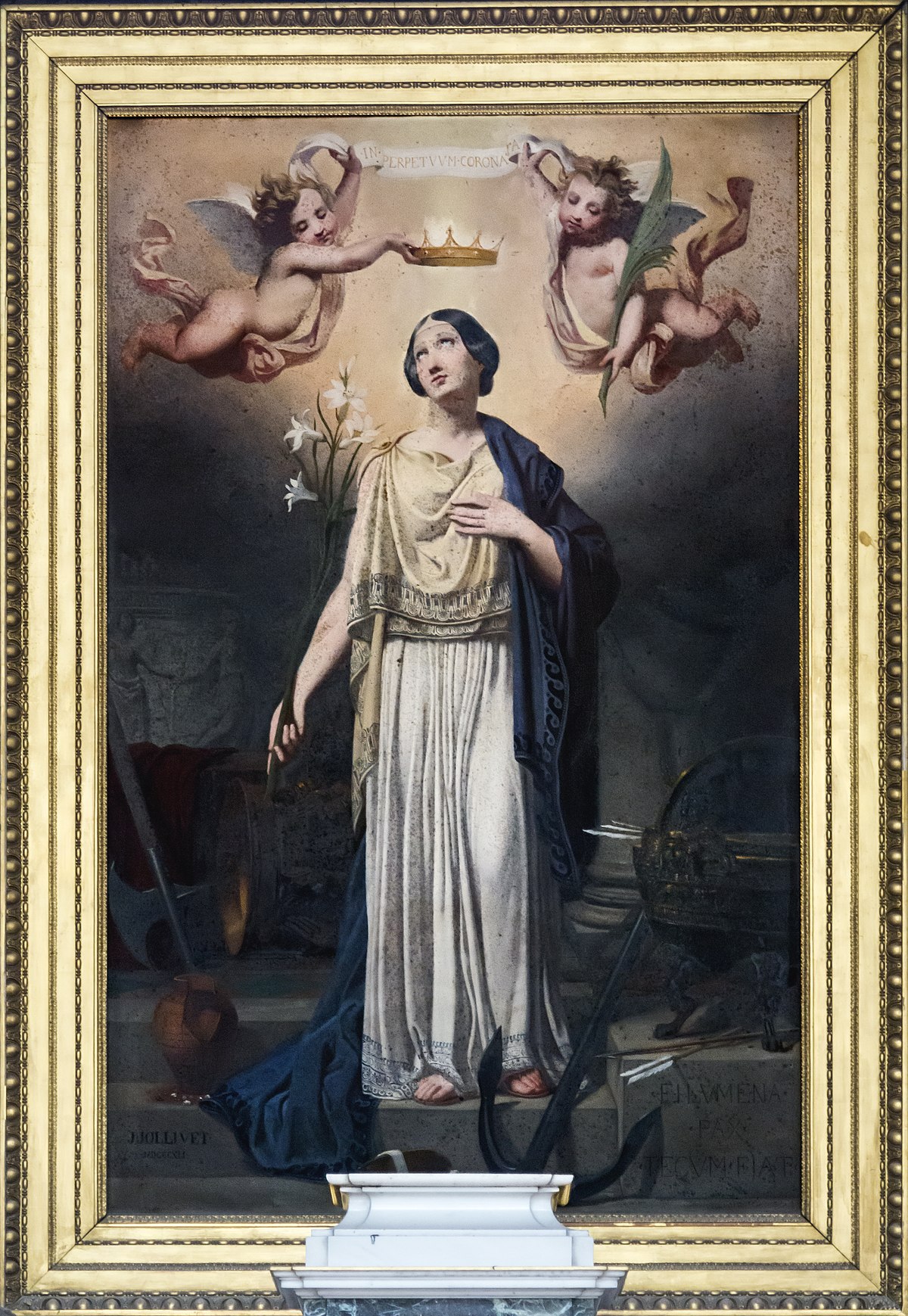
The elements that indicated the tomb of Saint Philomena to the discoverers in May 1802, and which were deciphered with the help of a Jesuit priest, Mariano Portenio, consisted of signs alluding to virginity and martyrdom; on the tombstone is inscribed the phrase -(fi)lumena, pax tecum fi(at)-, which translates as -Philomena, peace be with you: so be it-, which was the most common form placed on the tombstones of martyrs.

On the tombstone of her tomb were found inscribed symbols indicating death by martyrdom, they are; an anchor indicating that she was thrown into deep water, as happened to Pope St. Clement in the first century A.D., arrows recalling the way in which the life of St. Sebastian, 256-288, was taken by arrows, a palm drawn in the centre of the tombstone, symbolising the Christian triumph over evil (see article How the first Christians died).
Another of the symbols discovered was a whip, used with lead balls to cause the torture and death of the captured Christians, and a pair of arrows whose directions go from top to bottom, reminiscent of those sent by the Archangel Gabriel to Mount Gargano. They also found an image of a lily, symbolising the virgin’s triumph over the desires of the flesh and her purity before the world.
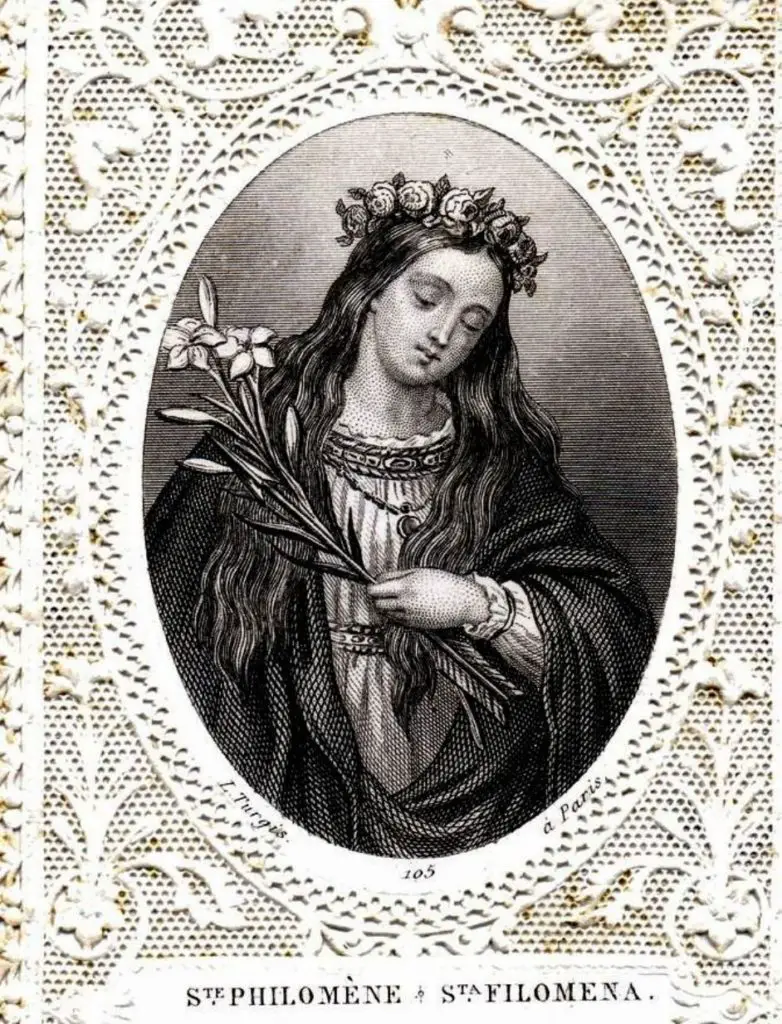
Among the objects found in the tomb of Saint Philomena, a glass vessel stands out, broken in the middle and impregnated with traces of blood, although it was clean. This is another indication that this body belonged to a martyred saint, since in the early centuries it was customary to collect the blood of martyred Christians in a vessel, in commemoration of the blood shed by our Lord Jesus Christ on the Cross. (See article on the symbols of early Christians).
The peculiarity of the glass jar containing the blood of Saint Philomena was that when we tried to take it out of the jar and put it in another glass jar, it kept its dark colour, but when we brought it close to the urn, it transformed into spherical particles that miraculously emitted the colours of the rainbow, mainly gold, ruby red, silver and crystalline like the purest diamond.
As for the relics of Saint Philomena, the bones of her ribs have wounds, her head has a cranial fissure and a large part of her teeth are still preserved. Her remains were taken under the protection of a priest called Francisco de Lucia, who first took them to Naples, to a bookshop, until September 1805, when he was able to transfer them to his parish church in Mugnano, in the metropolitan area of Naples, Italy.
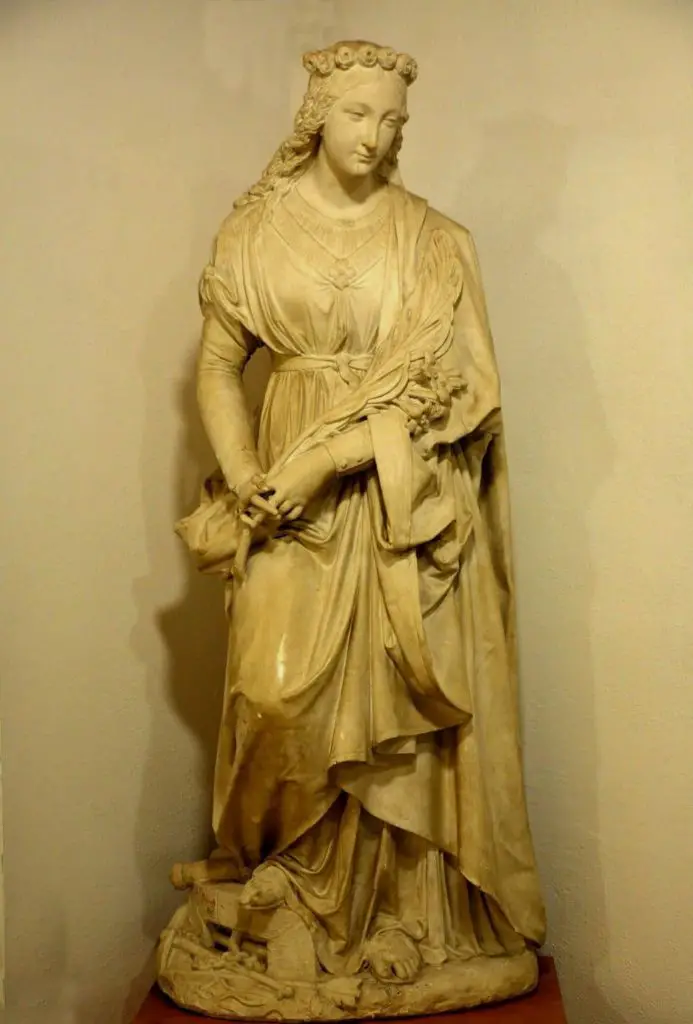
The story of Saint Philomena, which dates back to the first centuries of the Christian era, became popular after its discovery at the beginning of the 19th century, because with the arrival of her relics in Naples, in the church of Mugnano, the parishioners began to show their devotion to this saint, receiving quick and favourable answers to their petitions to her, and her miracles became very popular.
At the beginning of the 1930s, her fame had spread to such an extent that the first treatises and books on Saint Philomena appeared, which spoke of her revelations and the numerous signs found in her tomb, characterising her as a virgin maiden who died a martyr’s death. Pope Leo XII (1760-1829) declared her a great saint, and Pope Gregory XVI (1831-1846) allowed her to be venerated in public.
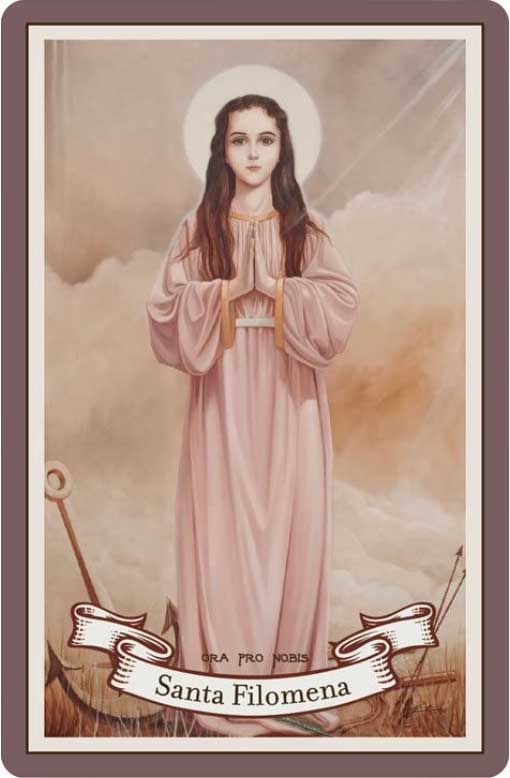
The cult of Saint Philomena became very popular from 1805 and by the middle of the century she was recognised as the thaumaturge saint of the 19th century, due to the number of miracles she granted to her followers. Her feast day is 11 August, and although she has not appeared in the martyrology since 1969, her cult is recognised by the Catholic Church. Her patron saints include children, the lost, the sick, the young and the poor.
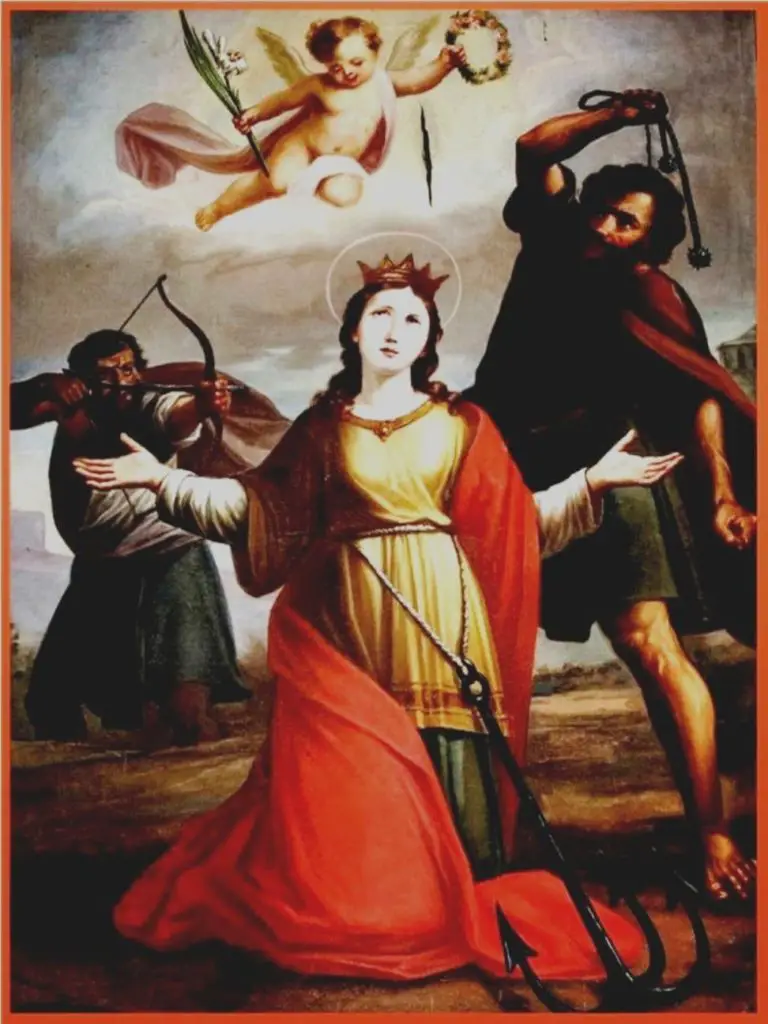
The iconography of Saint Philomena is based on the symbols inscribed on her tomb: an anchor, a lily, a whip, arrows, a palm and a crown. Although some studies of her hagiography question the true existence of this saint, considering her to be a legend that has not yet been fully verified, devotion to Saint Philomena continues to spread throughout the Catholic world. (See article on the beliefs of Catholics).
Saint Philomena Biography

The biographical sources of Saint Philomena come from the various documents printed after the discovery of her remains in 1802 in a cemetery in the city of Rome, and from the revelations given by this saint to three Italian people who lived at the beginning of the XIX century, above all from the revelations given to a nun to whom she revealed in detail her life and martyrdom. (See the article on the veneration of saints and martyrs).
St Philomena was a young woman very devoted to God and a practitioner of early Christianity. She lived at the time of the terrible persecution of the followers of Jesus Christ by the Roman Emperor Gaius Aurelius Valerius Diocletianus Augustus, 244-311, known as Diocletian, in the 4th century. St Philomena’s parents sacrificed her to the false gods, the god Jupiter.
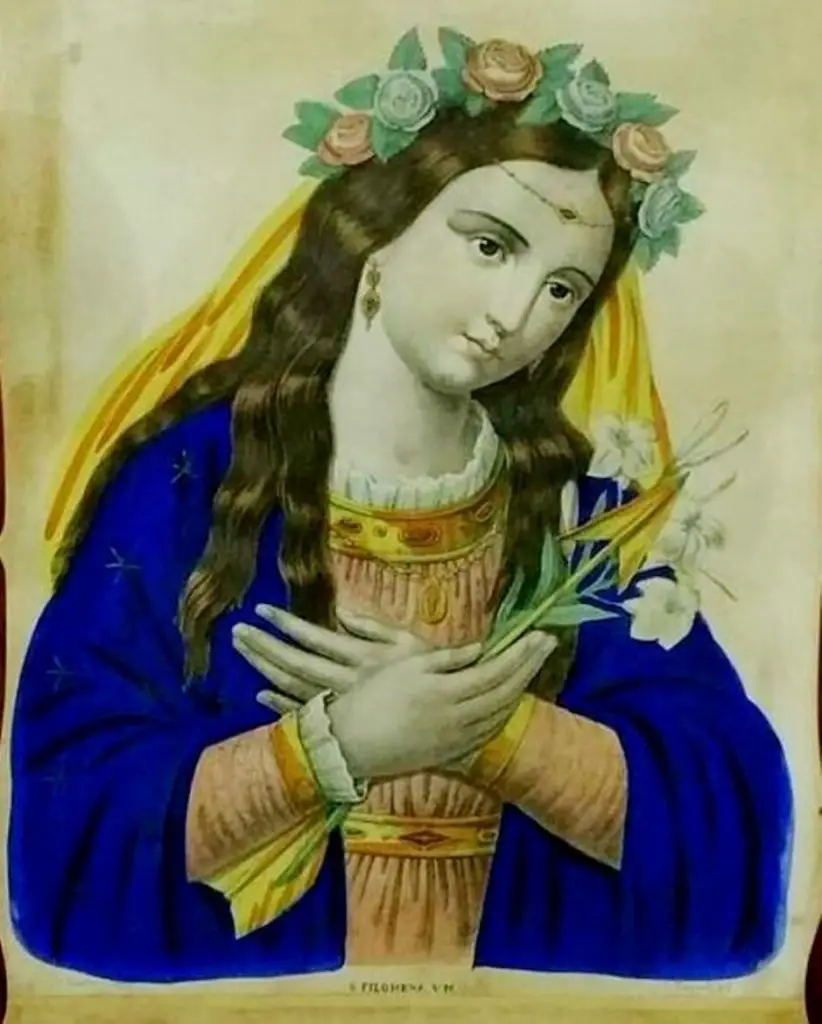
The chief physician of St. Philomena’s parents, who was a follower of Jesus Christ, as if inspired by the power of the Holy Spirit, urged them to convert to Christianity, suggesting that they accept God through the holy sacrament of Baptism, and promised to pray that God would grant them the joy of having children. God, for whom nothing is impossible, granted them the grace of having their firstborn daughter. (See article on the meaning of baptism).
When the parents of Saint Philomena realised that they were before the miracle of a true God, they consented to be baptised and made the Gospel of Jesus Christ the foundation of their faith, abandoning the pagan cults in which they believed. Saint Philomena was named Philomena because her parents wanted to leave a testimony that through their daughter the light of faith had been born in them, since Philomena means the daughter of light, the beloved.
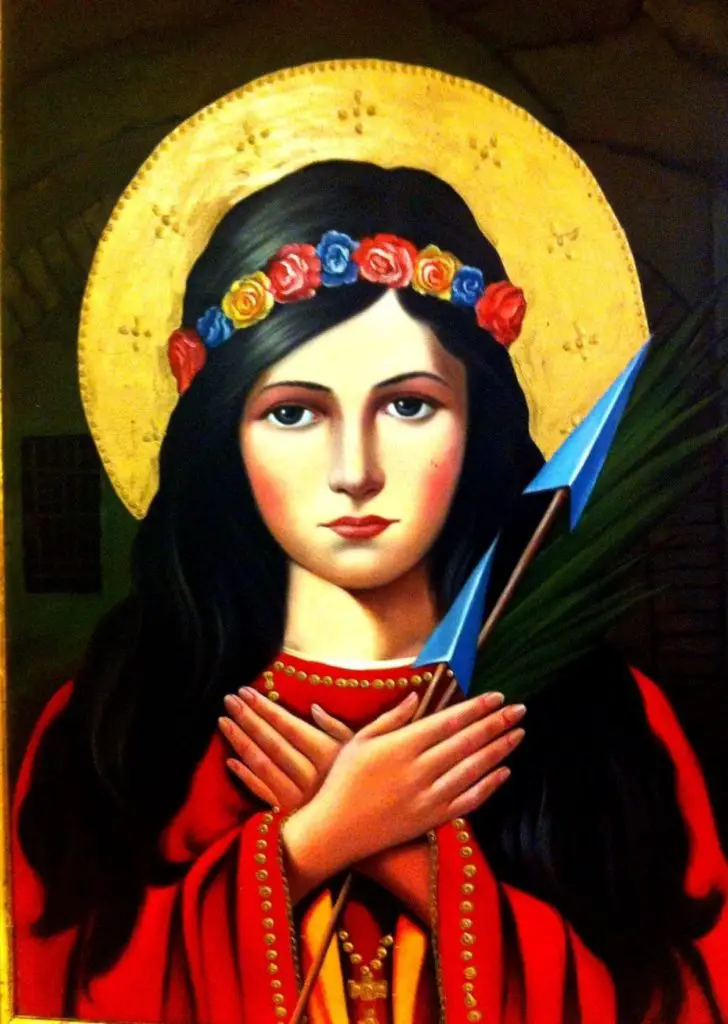
Saint Philomena was educated in the knowledge of Christian doctrine thanks to the Roman physician Publius, whom God has in his paradise for his faithful devotion to Jesus Christ. St Philomena says that her parents loved her very much, that she was an only child, the fruit of their new faith in God, and that thanks to the light that illuminated her life, she was able to know the true path that leads to eternal happiness, and that thanks to her, her spiritual blindness disappeared.
But tragedy befell this principality; St Philomena’s parents were Greek princes, but they were dependent on the imperial city of Rome, then considered the capital of the world. The misfortune of St Philomena’s household began with an unjust war threatening them, which led them to travel to Rome to ask for support from the cruel Emperor Diocletian.
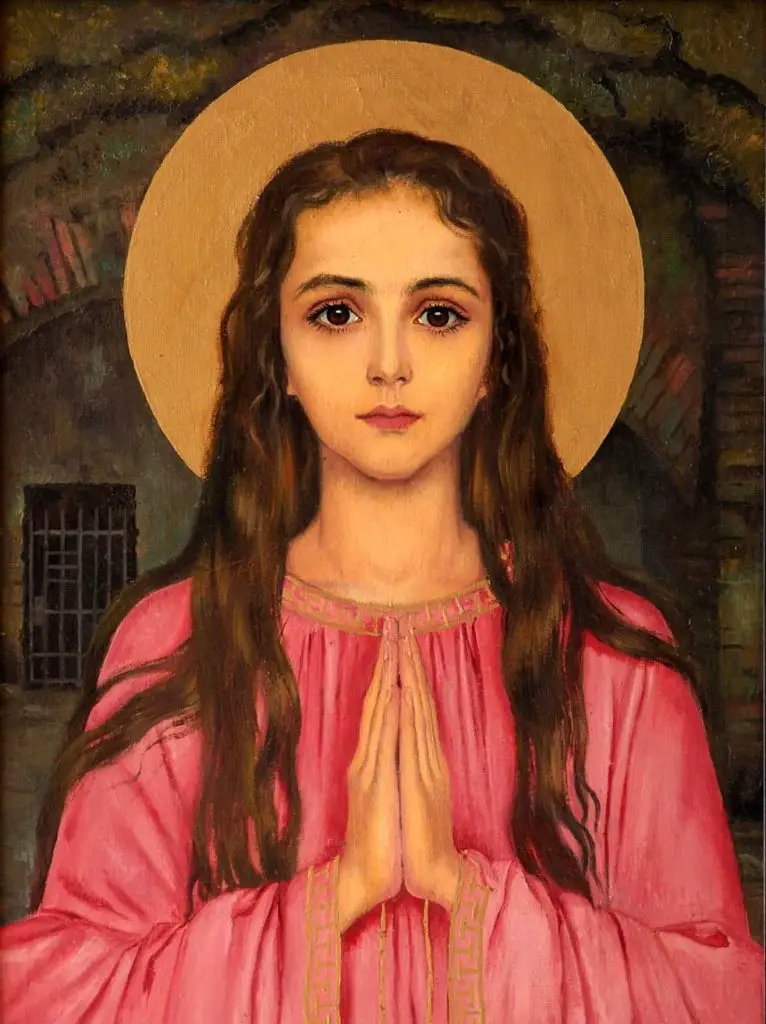
The autocrat Diocletian assumed the title of emperor in 284, a position he secured as a result of the Battle of Margus, which he won over another Roman emperor, Carinus, who was deposed by the imperial army after the battle. Diocletian ruled from 284 to 311, under the tetrarchy form of government, and it is believed that the events that befell the young Saint Philomena took place during this time.
St Philomena’s parents, whose names were not revealed, are known from the saint’s own revelations to have been Greek princes, but what she did reveal were the tragic events that befell her after she met the despotic emperor. Diocletian agreed to provide the military aid requested by St Philomena’s father, and the emperor assured her that she would live in peace and happiness.
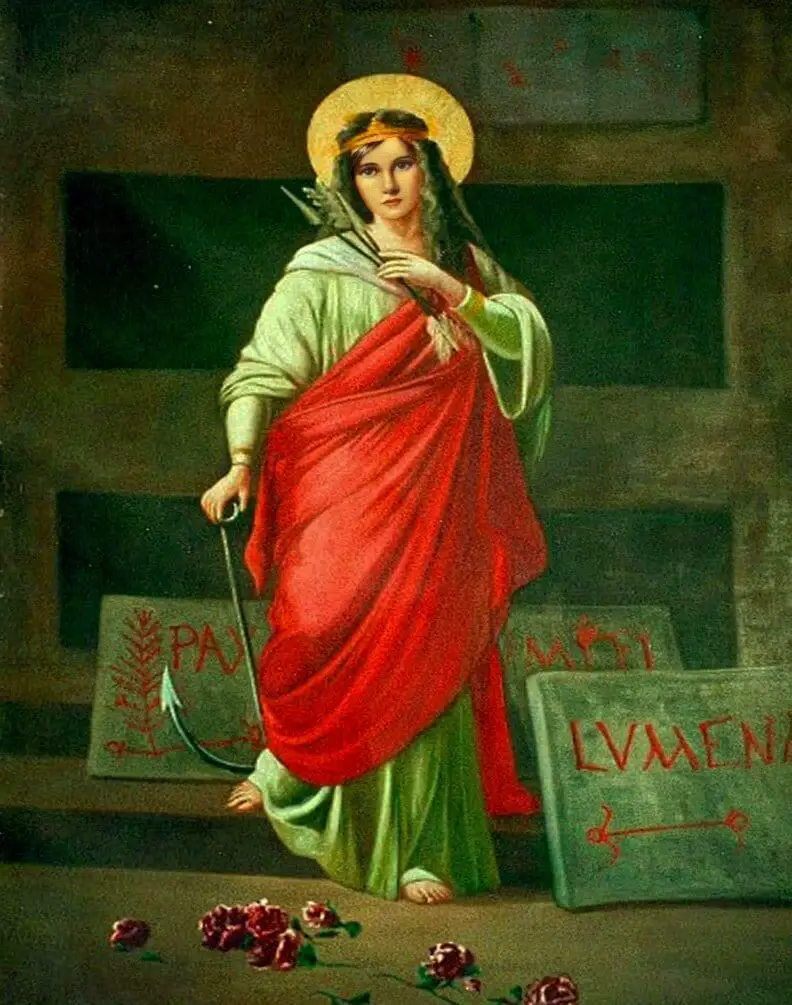
Raised in the knowledge of the one true God, St Philomena consecrated herself to Jesus Christ at the age of 11, taking a personal vow of virginity, just as St Elizabeth of the Trinity would do 1500 years later. Her love for the new Gospel of Jesus would sow in her a willingness to defend her faith, even at the cost of disobeying the commandments and customs of her time, a time when young virgins were given in marriage without their consent.
The Emperor Diocletian made it a condition of his military support for St Philomena’s father that he allow him to marry her, since he was so impressed by the young woman during the interview that he never stopped looking at her. St Philomena was only thirteen years old at the time, according to the saint herself, and since her vocation was to serve God, she refused to be given in marriage to the emperor.
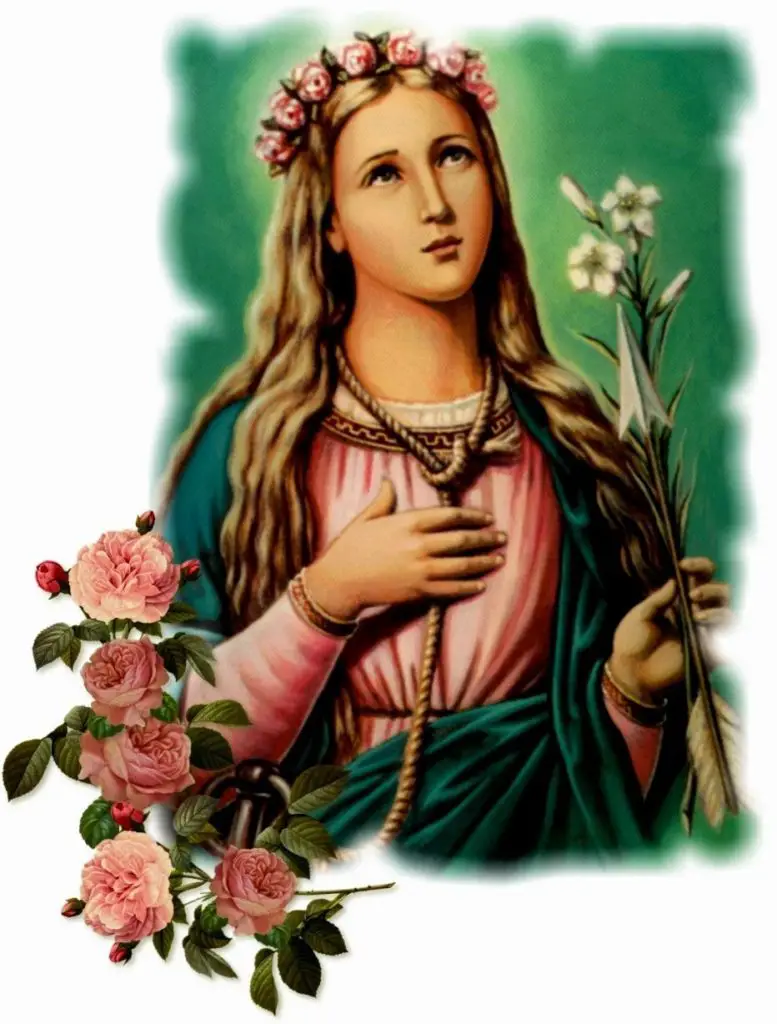
St Philomena’s father agreed to give his only daughter in marriage to the widower Diocletian because, in addition to receiving the military aid his region needed, he would also be placed in a privileged social position since his daughter would become Empress of the Roman Empire. St Philomena’s parents needed the military support of the Empire and agreed to give their daughter in marriage.
The grave error of St Philomena’s parents was that, perhaps out of ignorance, they did not take into account that the previous empress had been killed, together with her daughter, because she was a Christian. In those centuries of the rise of Christianity, it was almost common practice, and an imperial prerogative, for high Roman officials to reject their wives or concubines if they were practising Christians. (See article Characteristics of Early Christians).
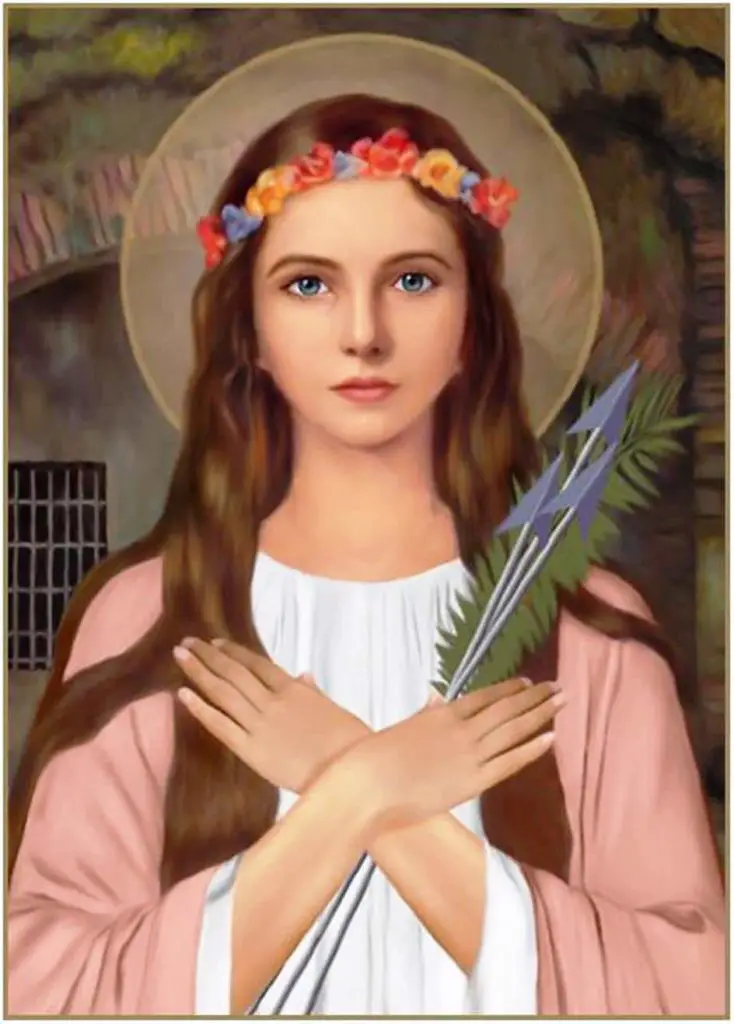
Since the parents of Saint Philomena were converts to the faith of Jesus Christ, for whom they abandoned their pagan rites, it is implausible that they would agree to hand over their only daughter, still a child, only thirteen years old, to a tyrannical governor who promoted the extermination of Christians and Manicheans, followers of the true God, and who was also the author of the death of his two previous wives, Prisca and Saint Serena, together with their two daughters.
According to these accounts, which many biblical scholars now consider to be stories based on unfounded legends, and which should therefore be excluded from the martyrology, they advocate the canonisation of the martyred empress Serena, considering that such a legendary figure did not exist and that her cult was based on the positioning of the rise of Christianity in the imperial court of those years.

It is also believed that Saint Serena and Saint Alexandra are the cult of the same figure of sanctity, arising from the tragic death of the wife of the Emperor Diocletian, called Prisca, who had to flee when she was discovered supporting the preachers of Jesus Christ, it would be a splitting of the cult something like what happens with Saint Eulalia of Barcelona, in Spain.
Only ignorance of the death of the previous wives of the Emperor Diocletian would justify her consenting to marry Saint Philomena to that ruler. Her father tried to persuade her with countless pleas, signs of love, telling her to do it for them, for her parents, for her country, for her subjects, they tired of begging her, but she, clinging to her faith in God, refused his pleas.
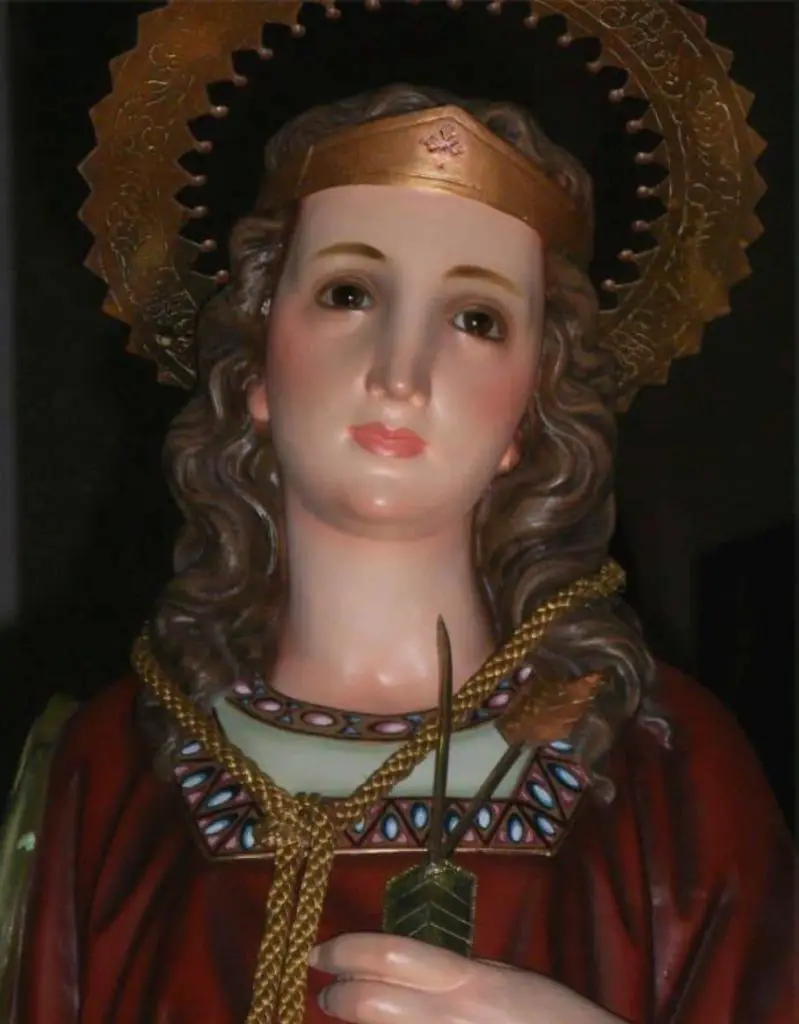
Saint Philomena tells us that she refused to marry the emperor because she was consecrated to Jesus Christ and her virginity was part of her Christian devotion, that she was ready to defend her purity before them, her parents, her country, and above all, that she aspired to the Kingdom of Heaven. Her parents brought her before the Emperor Diocletian because of her repeated refusals to marry.
Diocletian tried to persuade her to marry him, first with flattery and seductive promises, which proved unsuccessful, and then he threatened her, but Saint Philomena, faithful to Jesus Christ, did not listen to his pleas, so the emperor became furious like a demon and ordered her to be chained and imprisoned. St Philomena reveals that when she was imprisoned and bound in cruel chains, she was given only bread and water to eat.
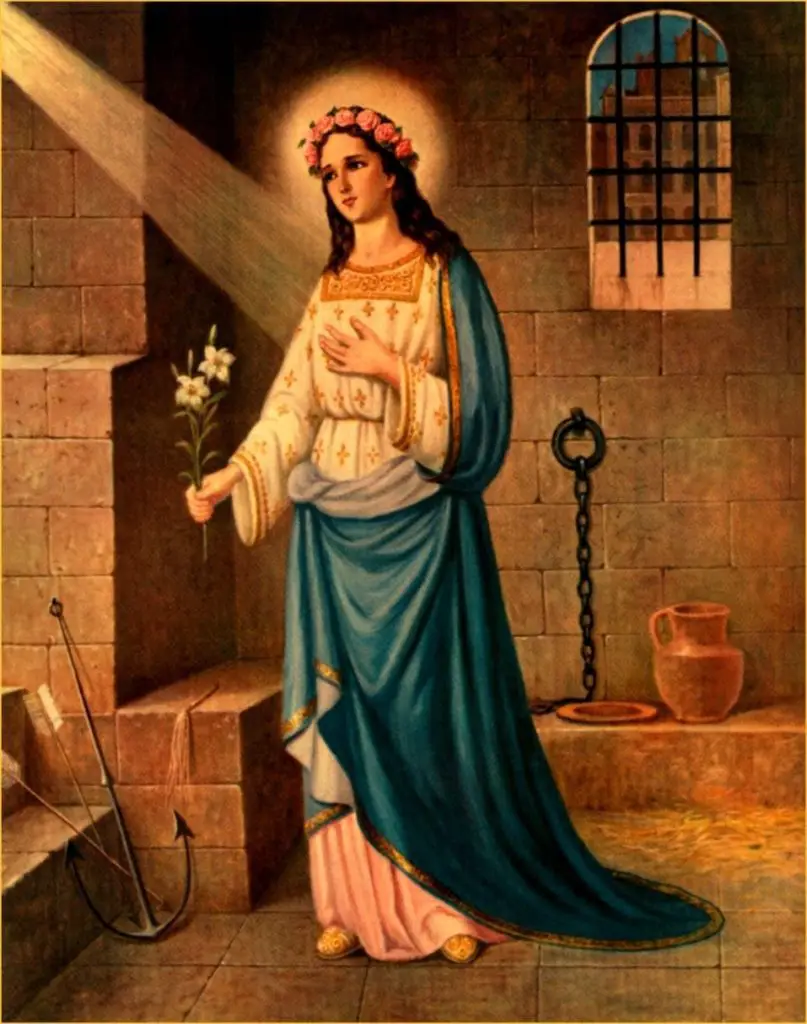
She already foresaw that this prison was the prelude to worse situations, because her virginity was seriously threatened in prison, but thanks to God her integrity could not be harmed. St Philomena sought consolation in prayer, raising her prayers to the Virgin Mary, to Jesus and to God, and five weeks into her imprisonment, the Blessed Virgin Mary appeared to her and announced that her tortures would continue for forty days.
St. Philomena tells us that when the Virgin Mary appeared to her in a radiant heavenly light, she told her that there would be stormy times ahead, worse than those she had already endured, but that it was a struggle that should not discourage her because she had been chosen as his favourite daughter, and that in these coming events the Archangel Gabriel would be at her side to help her with his great strength, being the angel of both of them.

The Blessed Virgin reminded Saint Philomena that her name means light, as does her Son, Jesus Christ, who, like her, the Blessed Virgin, is like the sun and the full moon, always shining in the midst of darkness; when the vision of the Blessed Virgin disappeared, the cell in which she was confined was filled with a heavenly fragrance, and she, Saint Philomena, recovered her courage, although she felt that her immediate future would not be at all pleasant.
The Emperor Diocletian, tired of trying to persuade her to marry him, began to confirm what the Blessed Virgin Mary had announced to her in the previous days: her struggle would consist in resisting with her faith the martyrdom to which she would be publicly subjected by the terrible Roman Emperor for refusing to comply with his infamous desires.
Diocletian warned her that she, Saint Philomena, would be punished with the same sufferings as Jesus Christ, and proceeded to have her scourged, stripped of her clothes and tied to a pillar in front of the courtiers of the royal palace; then, when she was healed, she was taken to the Tiber and tied to an anchor and an attempt was made to drown her, but by a miracle, by the angels, the rope of the anchor broke and she was saved.
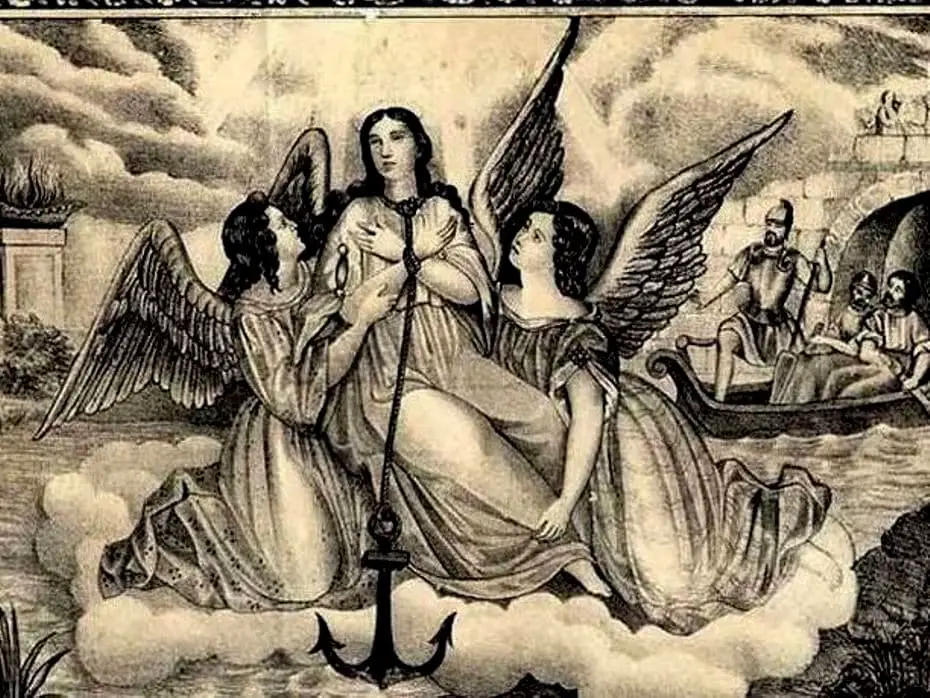
Another martyrdom she had to suffer was that of being dragged through the streets of Rome under a hundred arrows, almost dying, she was taken back to her cell where, by the grace of Divine Providence and the Archangel Gabriel, she was cured, but Diocletian remained blind to the miracles of God, miracles that were observed by the other Roman citizens and for which many of them were enlightened in their hearts and turned their minds to the true God.
A great number of people who witnessed these barbaric acts, which many rejected, began to become Christians, the light of God who enlightens the hearts, and who, a few years later, would impose Catholicism as the official religion of that decadent empire, because He is a living God who performs great deeds in His believers, but the cruel emperor remained blind to the miracles of God performed in the person of Saint Philomena.
Seeing no way of killing Saint Philomena, and the fact that this young girl would not submit to his insane demands, but with each torture her faith grew stronger, and moreover, because of her cures, he believed her to be a magician, so he arranged for her to be killed by means of hot darts, which his arrows would shoot at her, but once again his attempt at murder failed, as the red-hot arrows struck in the opposite direction, killing about six arrows.
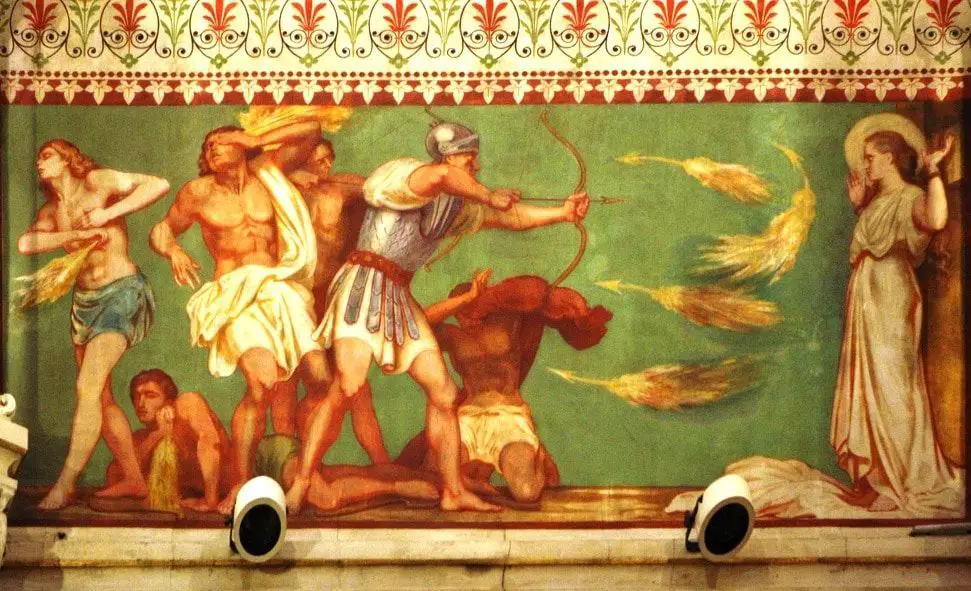
The crowd, witnessing these atrocities against a young Christian girl, began to praise publicly the God in whom this girl had put her faith and whom the angels had protected by healing the wounds of her martyrdom: the Emperor Diocletian, still blind before God, or perhaps already possessed by Satan, against whom Saint Philomena was really fighting, and who, anticipating that the people would rise up against her, ordered her beheaded.
It was on a Friday, on the same day and at the same hour, that the order of the dark tyrant, the Emperor Diocletian, was carried out, that Saint Philomena should be executed by cutting off her head, because she insisted on refusing his demands for marriage, and in order to calm the threatening public disorder, because of the support that the Christian doctrine was receiving, thanks to the miracles performed on Saint Philomena.
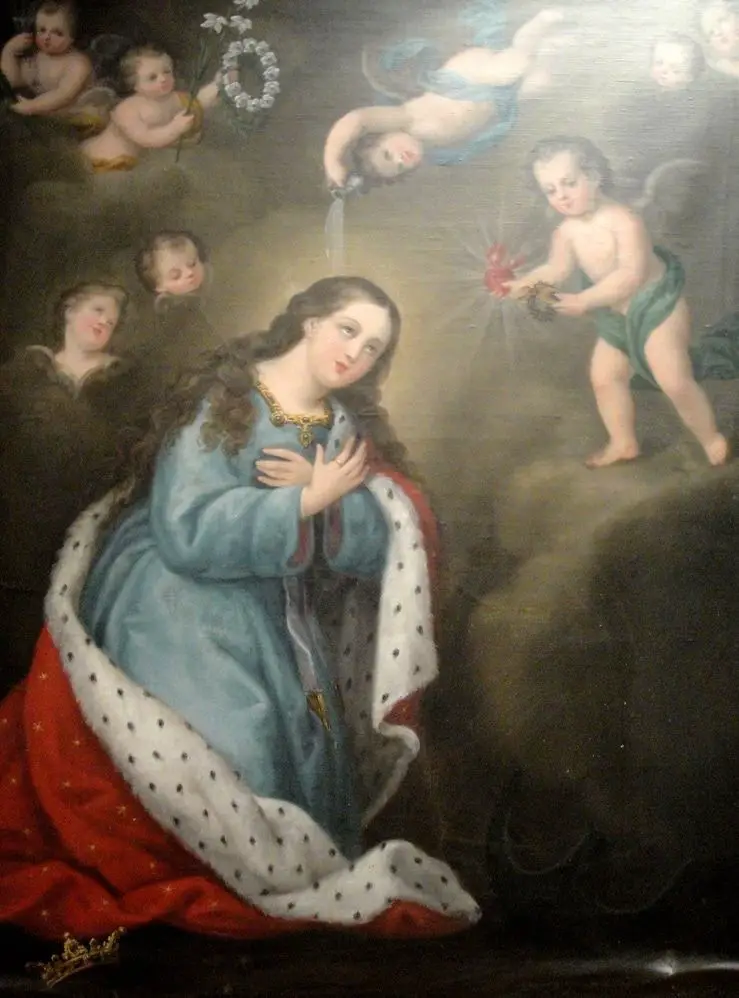
Saint Philomena tells us that her soul has entered the eternal Heaven, next to her heavenly Spouse, Jesus Christ, that by winning this bloody battle against human impiety and satanic influence, she received the palm of martyrdom and is happy before the divine presence of God, among the chosen ones to live eternity, her short life was a testimony of the great power of God before the atrocities of men, before the wickedness that the devil inspires.
St Philomena is a faithful reflection of the great power of the Holy Spirit that works in us when we truly love God and put our faith in Him before all things and people of this transitory world, she is an example of how the Blessed Virgin is a living presence that helps us in the most difficult trials, of how Jesus Christ and His angels work miracles in people, she is an example of the help that Divine Providence gives us. (See article on Prayer to the Angels).
Story of St Philomena and her miracles
The devotion to Saint Philomena began at the beginning of the 4th century A.D., when the Roman Empire extended its sovereignty over a large part of Europe and was a government that persecuted and martyred the first Christians for their pagan practices. St Philomena suffered a cruel martyrdom in defence of her faith in God, and in such events there were miracles given by Divine Providence which strengthened the light of Jesus Christ in those who witnessed them.
After their bloodthirsty murder, their remains were taken to the Roman cemetery, now an antique, where the remains of the first martyrs of Christianity are still being unearthed. Some 1,500 years later, in 1802, her tomb was discovered, containing not only her remains, but also inscriptions, signs, objects and drawings, which indicated that her tomb belonged to a very young martyr.
In 1805 her holy relics arrived in the Neapolitan region of Mugnano and were placed in the church of this parish. A nun, Mother Superior, received an image of Saint Philomena and prayed to her to intercede for her and heal her of her brokenness. The nun, seeing herself healed, became more and more interested in the saint and prayed to her to know her story, and one fine day the nun fell into a trance and received the revelations she had asked for.
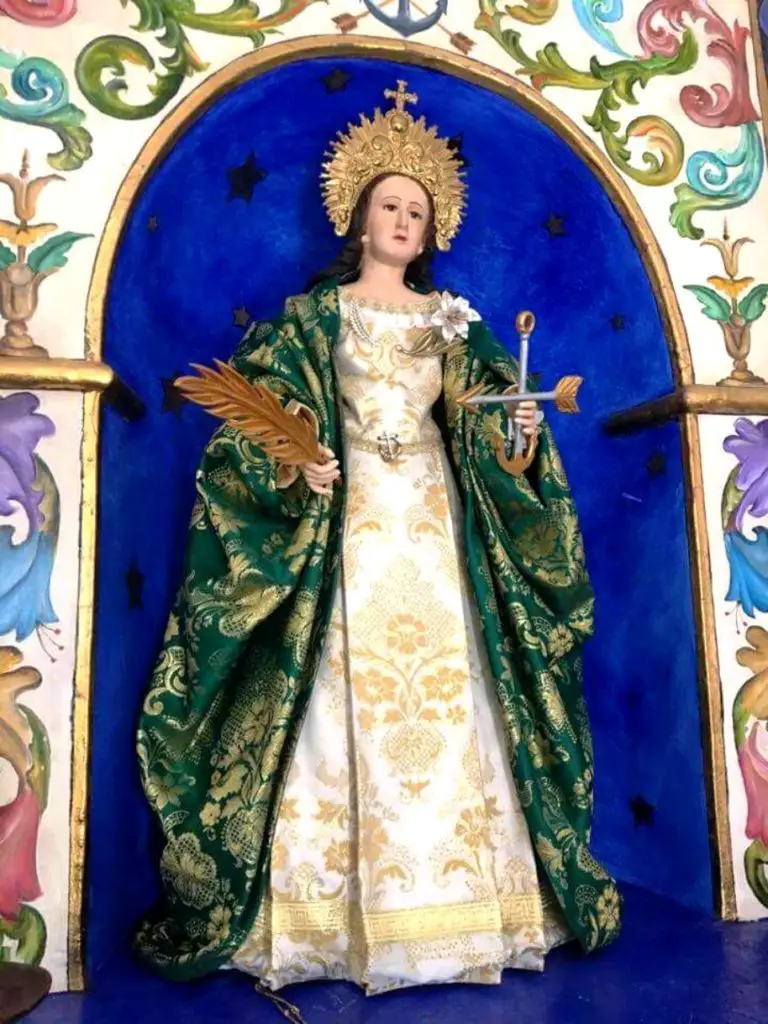
The nun, Mother Superior of that Italian city, and a virgin consecrated to the service of Jesus Christ, by means of revelations which probably took place between 1805 and 1825, the years before the first impressions of the story of Saint Philomena appeared, and which caused her to enter into mystical trances, informed her of her origin, her short life, and how and why she was martyred at such a young age.
These revelations were also given by St Philomena to two other persons, a humble craftsman and a Jesuit priest, and they were then compared, and it was found that all three agreed in their details, but the descriptions given to the superior were more extensive, so that they were taken as the true history of this young woman of the third century, and since the three accounts agree, her existence is considered certain.
Saint Philomena is a religious figure of Catholicism, considered to be a legend because her presence is proven by the inscriptions on her tomb and the revelations she gave to three different people, which were subject to subjective judgements and later hagiographic verification. For these reasons she was removed from the martyrology in 1969, although her cult is authorised by the Church.
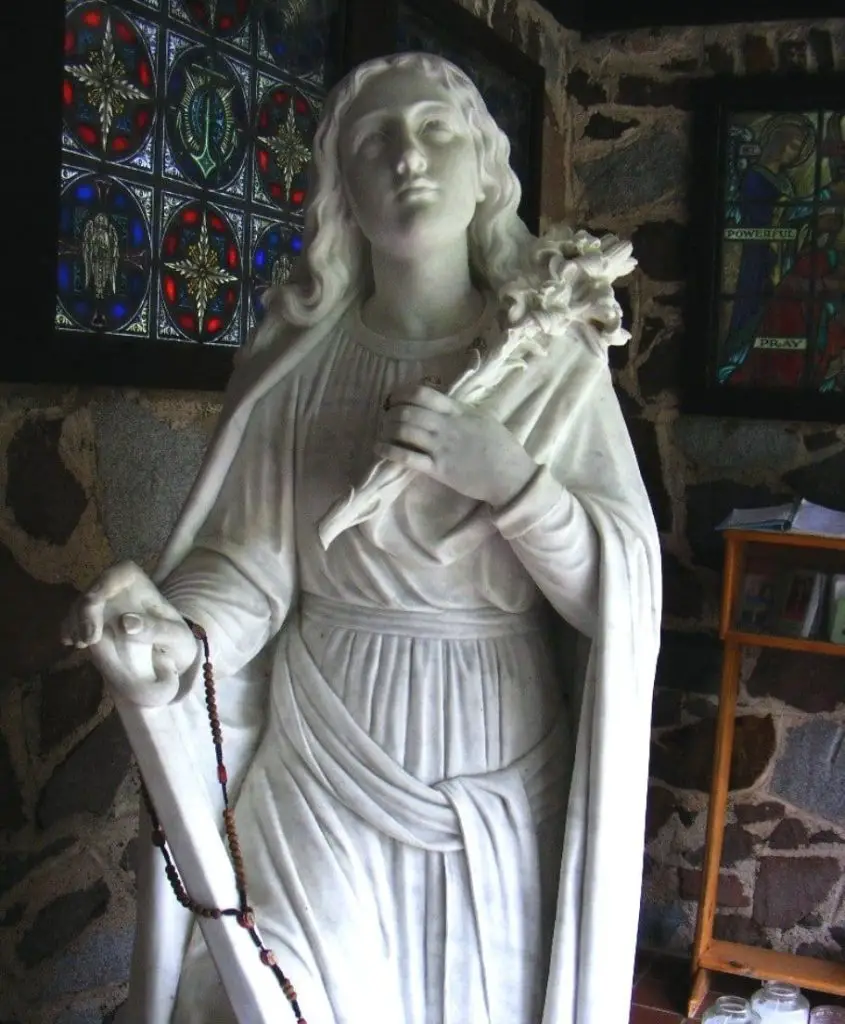
The story and miracles of Saint Philomena, according to the revelations made to the 19th century nun superior and the elements found in her tomb, tell us that she was born in the late 3rd or early 4th century AD, at the time of the Emperor Diocletian. His parents were aristocrats, Greek princes, who, unable to have children, converted to Christianity at the behest of the chief physician of their palace.
The doctor promised them that he would pray for them to have a child. When the miraculous pregnancy occurred, they were convinced of the great power of God over his followers and agreed to be baptised as Christians, abandoning the pagan cults that prevailed at the time, and in honour of their new faith they named their daughter Philomena, alluding to the daughter of light, an illumination that dispelled the shadows of paganism within them.
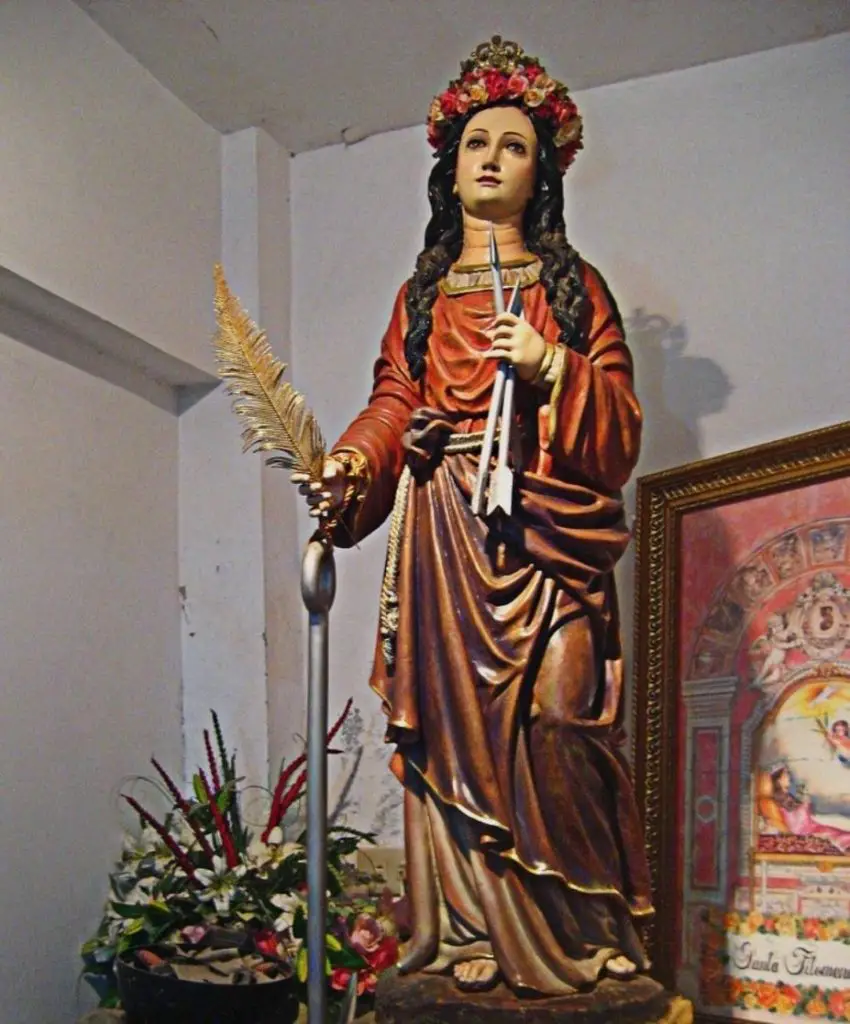
At the age of thirteen, he accompanied his parents to an audience with the Emperor Diocletian, where they asked for the help of the imperial army because their principality was threatened by war. During the interview, the Emperor looked at the young St Philomena and promised her father all his military support, but made it an inescapable condition that his daughter should marry him.
St. Philomena’s parents agreed to the king’s request, but they did not take into account that two years earlier, in accordance with her growing love for Jesus Christ, St. Philomena had taken the vow of virginity, thanks to the Christian education she had received since birth, and that she was committed to practising Christianity by helping the poor, and for these reasons she refused to be given in marriage outside the imperial palace.
Her father tried to persuade her in various ways, including serious threats, asking her to do it to save her country, her vassals and her parents; her mother intervened and tried to persuade her in the same way, but their attempts were in vain, because Saint Philomena told them that her virginity and her soul belonged to Jesus Christ, of her own free will, and that she preferred Holy Heaven to everything and everyone.
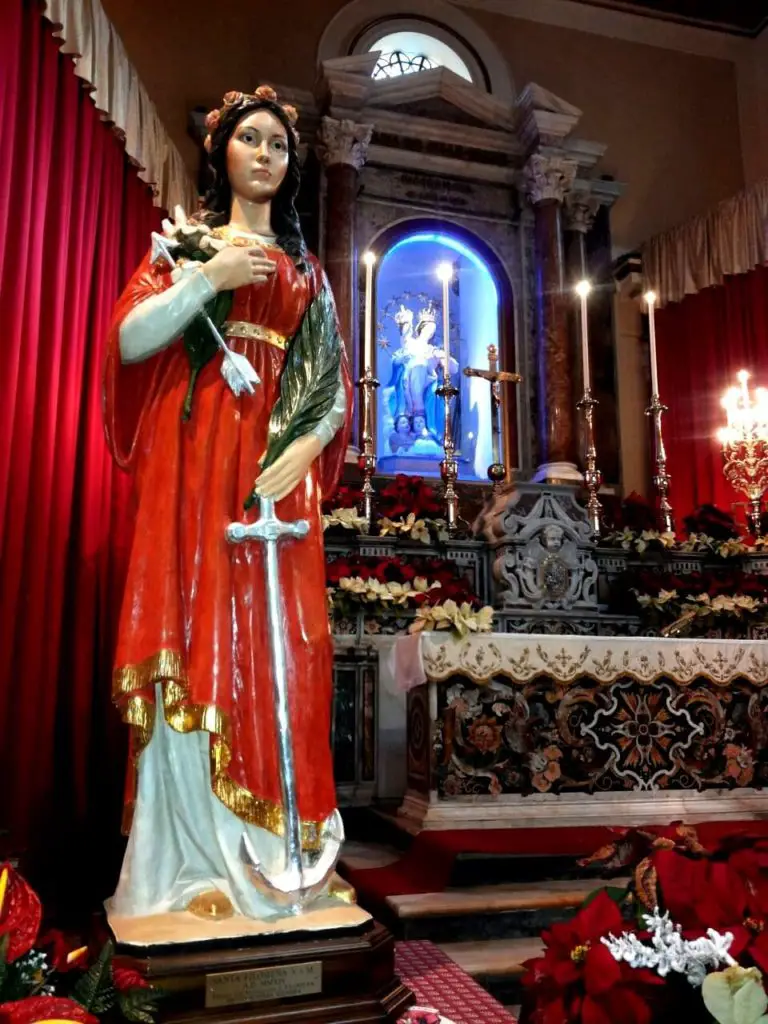
Diocletian tried to persuade her to agree to his demands, he tried to seduce her with flattery and gifts, but the young maiden continued to refuse the marriage, so the emperor was furious because he considered himself equal to the god Jupiter, the superior deity of his beliefs, and would not allow himself to be scorned, so he decided to imprison her.
Before being imprisoned, St Philomena was severely flogged, naked and tied to a pillar of the royal court in front of the courtiers. In her cell she prayed. Then the Blessed Virgin Mary appeared to her, healed her wounds and told her that her imprisonment would last another 40 days, after which she would have to fight a hard battle, but that the Holy Spirit, she and the Archangel Gabriel would be on her side.
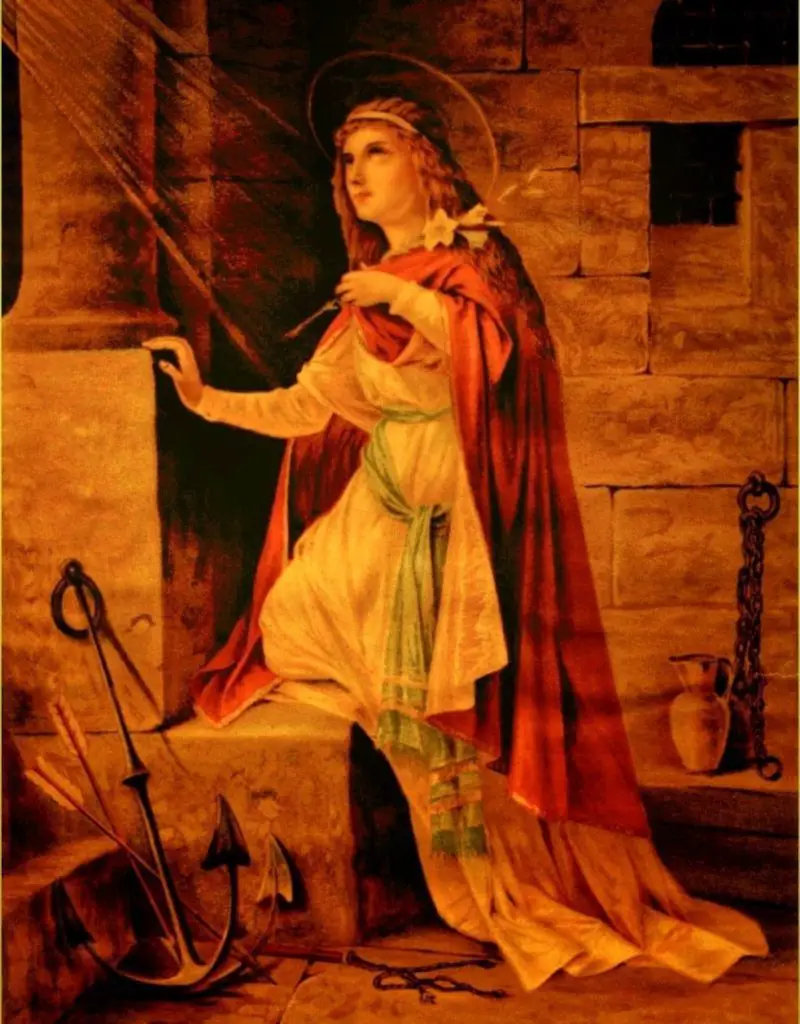
Diocletian, a cruel persecutor of Christians, decided to subject Saint Philomena to the torture of martyrdom because of her repeated refusals to marry him and because he was convinced of the young prisoner’s devotion to Jesus Christ. She was dragged through the streets of Rome while arrows were shot at her, she died and was taken back to her dungeon, but St Gabriel the Archangel and other angels healed her wounds.
Later, seeing her healed, they set out to end her life by shooting arrows at her with hot darts, but these arrows failed to hit her humanity and instead flew back at the archers, killing six of them. She was taken to the banks of the Tiber, where she was tied to an anchor and thrown into the water, but the angels, led by the Archangel Gabriel, broke the rope holding the anchor to which St Philomena was tied.
The Emperor Diocletian, seeing that there was no way to kill Saint Philomena, and fearing that the people would recognise her as an example of God’s power, ordered her beheaded, an order which was carried out on Friday the 10th of August at three o’clock in the afternoon, the same time that Jesus Christ died on the cross. In her revelations, St Philomena says that she is in heaven with God’s chosen ones (see article on what Jesus Christ died of).
The miracles attributed to Saint Philomena begin with her miraculous birth, her devotion to Jesus Christ, the miracles she received from the Virgin Mary, Jesus Christ, the Holy Spirit and the Archangel Gabriel during her imprisonment and martyrdom, and her conversion to Christianity, which produced her unwavering faith in God among the people who witnessed the atrocities inflicted on her by Diocletian and his Roman soldiers. (See article on who the Holy Spirit is for Christians).
Since the beginning of the 19th century, her miraculous apparitions have spread from Naples to all of Europe and, above all, to the American and Asian continents, where Saint Philomena is considered the thaumaturge saint of the 19th century because of the various miracles she grants to those who pray to her (see article on what are the miracles of Jesus Christ).
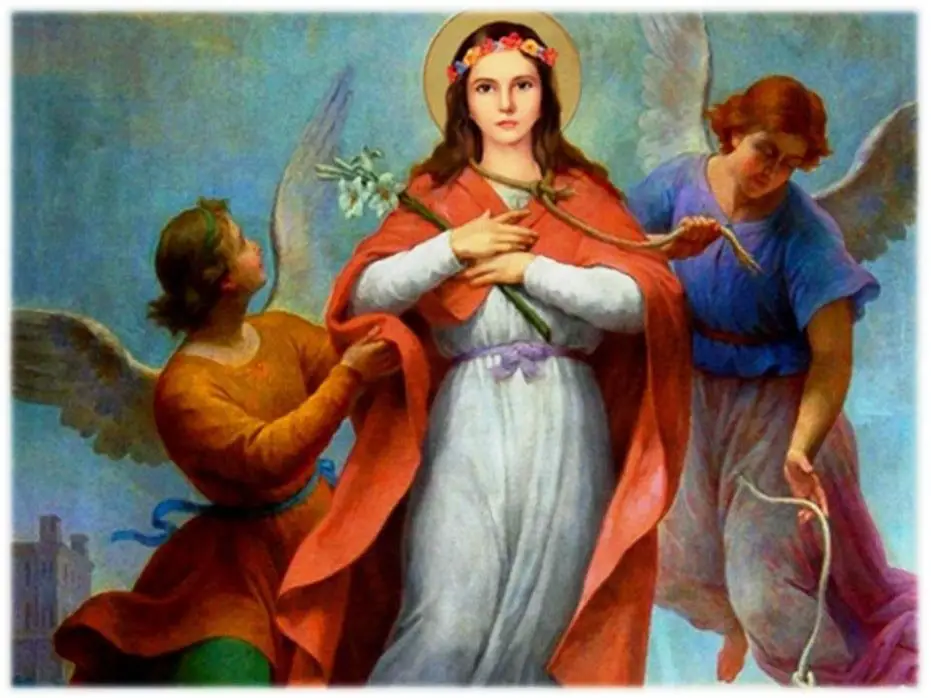
Their miracles include healing wounds, rescuing people from difficult situations, caring for children and young people, strengthening faith, encouraging the desperate, warding off sickness and bringing babies into the world. His arrival in the village of Mugnano, Italy, was accompanied by abundant rainfall, ending almost a year of drought which had threatened the village with famine due to a lack of crops.
The oil of the lamp in which her statue is placed is considered miraculous because, since it was transferred to the village of Mugnano in 1805, this oil has cured all kinds of illnesses; even in the first years of its existence it was in great demand because there were testimonies that it was able to cure even blindness and other illnesses that were considered incurable.
Saint Philomena, Virgin and Martyr
The cult of this saint has its origins in a tomb discovered in the ancient cemetery of Rome, on the Via Salaria in Prisca. This tomb, excavated in 1802, contained the remains of a young woman and had symbolic inscriptions indicating that it was the tomb of a martyr from the early years of Christianity. These engravings were later studied by a Jesuit priest who was an expert in biblical history (see article on how the first Christians died).
The signs were arrows, a pair of which were pointed in the opposite direction to their target, an anchor and a whip, instruments used to martyr the followers of Jesus Christ in the first centuries. In addition, drawings of a lily and a palm tree were found, representing the virginal purity of virgins, and the name of this martyr was found on the tombstone, it reads -Philomena peace be with you: so be it-.
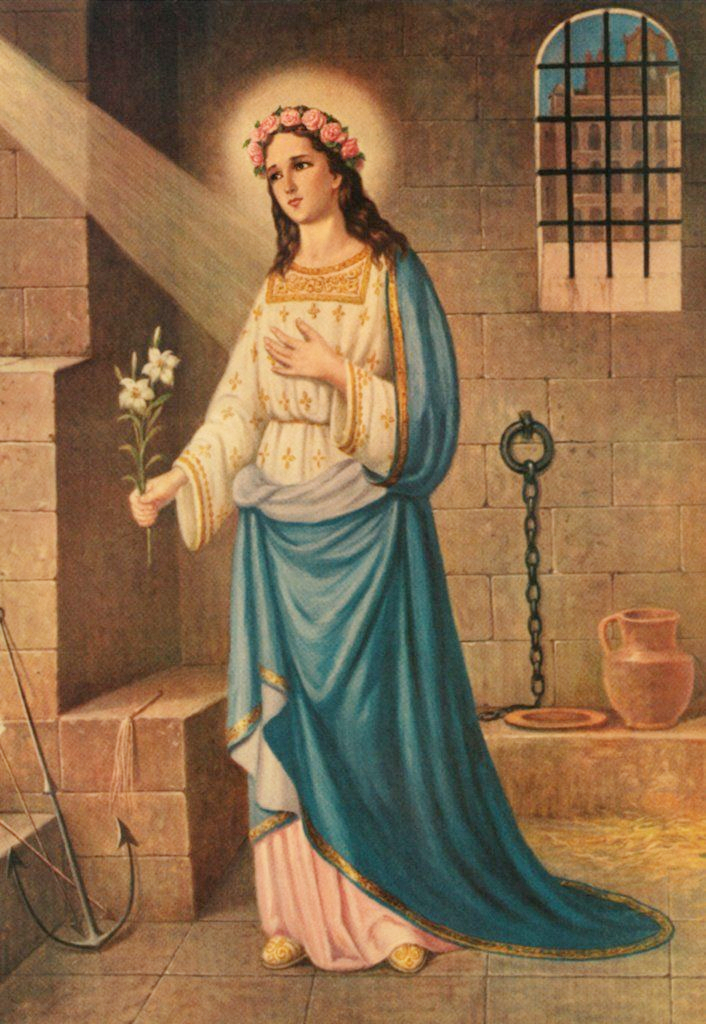
Another element discovered in the tomb of Saint Philomena was a glass vessel containing traces of blood, which was a historical indication that this body belonged to a martyr, since it was the custom that when a Christian was executed, his blood was taken in memory of the blood shed by Jesus Christ on the Cross; when the bones were analysed, it was found that they belonged to a girl of about thirteen years old.
The mortal remains of the martyr Saint Philomena were taken in 1805 to a village near the city of Naples, Italy, called Mugnano, where they remained for some time without her story being known. Her identity and the story of her life were revealed in visions to three people of sound moral character, to whom Saint Philomena manifested herself in order to make known to the world who she was and how the events of her death occurred.
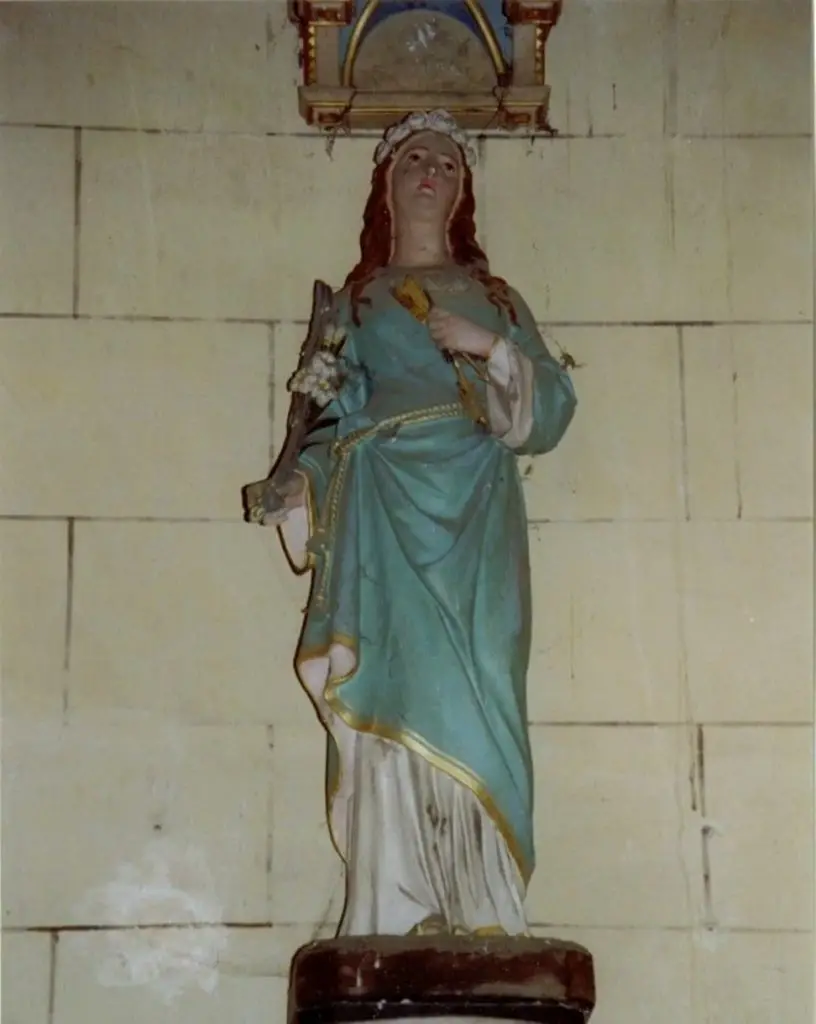
These three accounts, given to a priest, a craftsman and a nun, coincided in many details, although they lived in distant places at the same time. The revelations that shed the most light on the life of Saint Philomena were those described by the nun, who was then a mother superior, about 34 years old, consecrated in soul and virginity to the service of God, and who received some of the first miracles of this saint.
The nun had acquired a simple image of Saint Philomena in the parish church where her remains lie; she says that after praying to her, the saint manifested herself to her for the first time, putting her in a trance and curing her ills; then the manifestations returned; it was then that she began to receive revelations with details of the life and martyrdom of Saint Philomena, a saint who began to be an object of veneration by visitors to the local church.
In her revelations, Saint Philomena tells us that she was the daughter of Greek princes who lived in the time of the Emperor Diocletian, that she was a fervent follower of Jesus Christ, to whom she consecrated her life and virginity at the age of 11, but that her parents, seeking military aid from the Roman Empire, had to travel with her to Rome for an audience with the monarch.
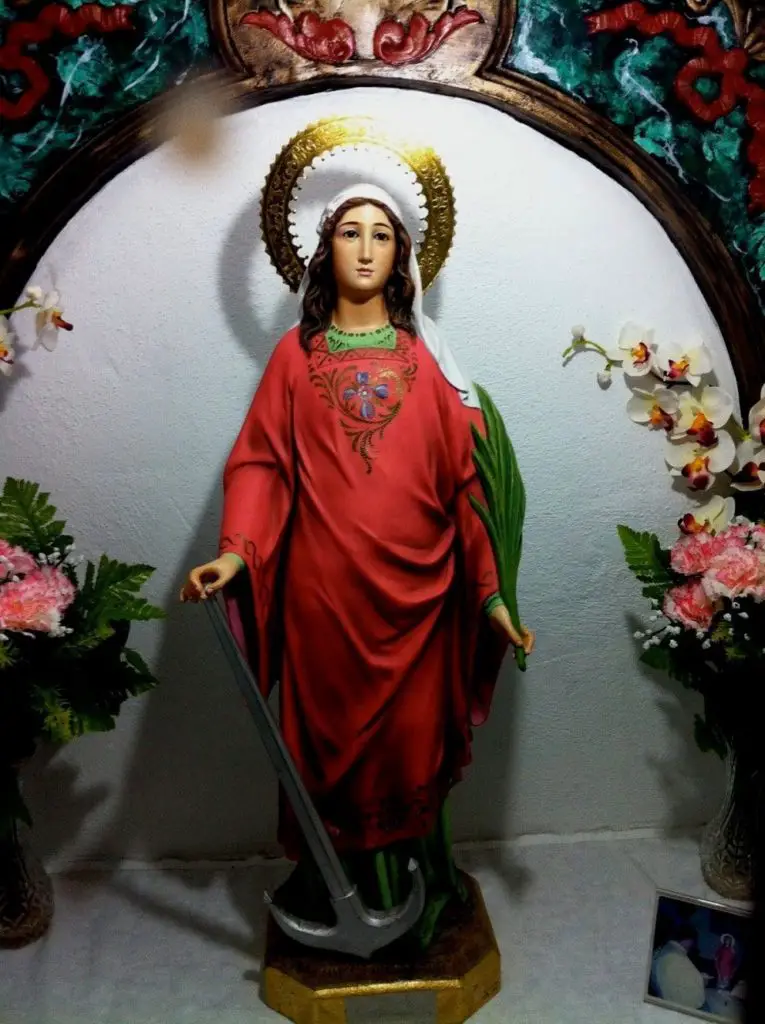
In the interview with Diocletian, he showed his interest in the then thirteen-year-old, but as he was a widower, he asked her to marry him in exchange for the support of the imperial army that her father wanted. Saint Philomena tells us that she refused the Emperor’s request and told her parents, who tried to persuade her, but when they were unable to do so, she was taken to Diocletian.
St Philomena continued to refuse the king’s marriage proposal, and when he saw himself rejected, he imprisoned her and, being a cruel persecutor and murderer of Christians, condemned her to suffer the torture of martyrdom. During her imprisonment, the Blessed Virgin Mary appeared to her, consoling her and telling her that she and the Archangel Gabriel were ready to help her because she had been chosen as his favourite daughter.
During her martyrdom, which consisted of being whipped naked, thrown into the waters of the Tiber and dragged through the streets of Rome, the angels of heaven, under the command of the Archangel Gabriel, protected her, quickly healing her wounds and preventing her from drowning in the river, breaking the rope tied to the anchor with which the Roman soldiers wanted to kill her.
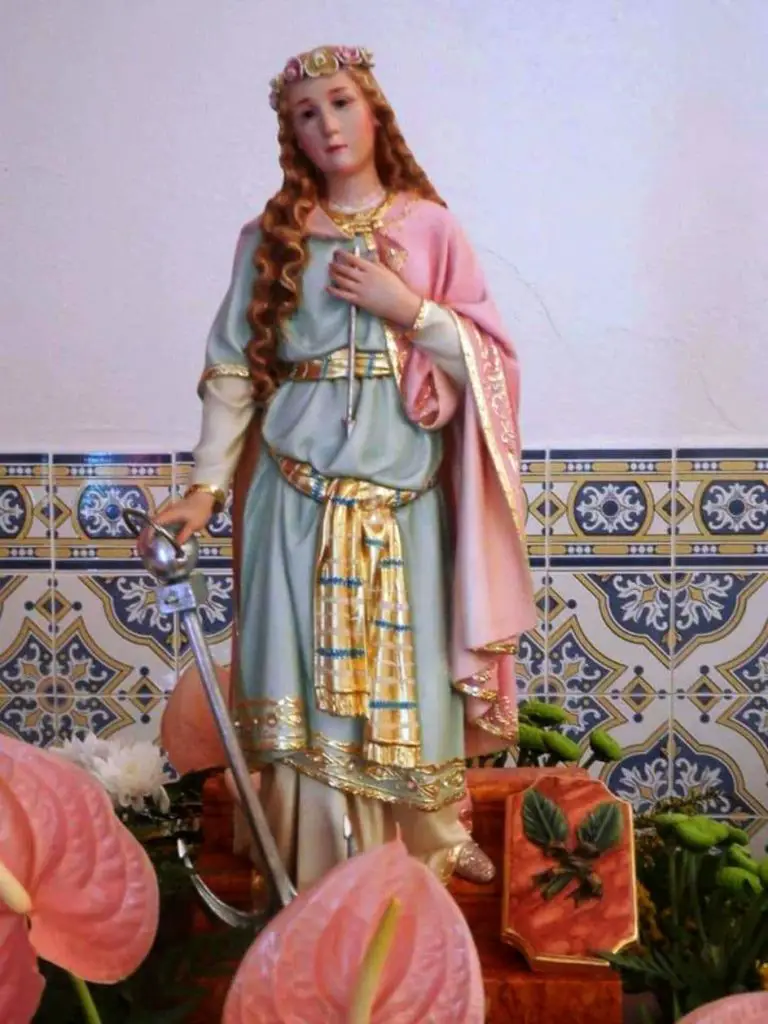
The Emperor, seeing that he could not end the life of Saint Philomena, decided to behead her, since the people could see that she had been healed and saved by a God who truly protects his faithful followers. Her beheading took place on 10 August at three o’clock in the afternoon. St Philomena reveals that this is her story, how she became a young and virginal martyr at the age of thirteen.
Saint Philomena, patron saint of barren women
St. Philomena is the patron saint of barren women, babies, the Living Rosary, young students, adolescents, and she is also the patron saint of difficult, desperate causes that are considered impossible or lost. She can also be considered the patron saint of young virgins, of women consecrated in virginity and soul to Jesus Christ, of unjustly imprisoned adolescent girls and of those who defend their faith in God.
Her feast day is celebrated every year on 11 August and is considered a cult of growing popular devotion, which began in Italy at the beginning of the 19th century in the town of Mugnano, from where her veneration has spread to the rest of the peoples of the world, because she is considered a miraculous saint who was martyred for defending love of Jesus Christ, God and the Virgin Mary, of whom she is one of her favourite daughters.
Phrases of Saint Philomena
Since Saint Philomena is still a legendary figure, believed to have lived in the early 4th century, and since there are no manuscripts to prove her existence, it is almost impossible to attribute verifiable phrases uttered by her, but since for the omnipotent power of God (see article on God) nothing is impossible in the universe, her phrases come to us through the miraculous revelations made to a priest, a craftsman and a nun, all born in 19th century Italy.
From the revelations given to the artisan, it is not possible to extract any sentences, since his story revolves around the anger of the Emperor Diocletian when he found himself rejected by Saint Philomena, from the priest who helped to decipher the signs of her tomb and to whom this Saint appeared one day while he was walking in a lonely field, we can extract the following sentence about her: -There is so much to know about me that the world will not be able to get out of its amazement -, which indicates how wonderful she is.
From the nun and Mother Superior we receive the most detailed revelations of Saint Philomena, from which we can extract the following sentences, which encourage us to follow the paths shown to us by the stories of the first Christians, the Acts of the Apostles, the four Evangelists, especially Saint Luke, and all those who work in faith and action for the Christian, Catholic doctrine;

- -The eternal goods of heaven are incomprehensible to the human mind; love for a person is no justification for lacking Jesus Christ; consecration to God in soul and virginity places love for Jesus Christ above all things and persons; our kingdom must be heaven; God gives us a place in heaven, marked by His divine presence.
The feast of Saint Philomena
The liturgical celebration of Saint Philomena takes place on 11 August, although in her revelations she mentions 10 August, the date on which she was beheaded during her martyrdom at the hands of the tyrant Diocletian. Other dates in her saint’s calendar are 10 January, which celebrates her possible birth, her patron saint’s day is celebrated on the Sunday after 10 January and the transfer of her remains is commemorated on 10 August.
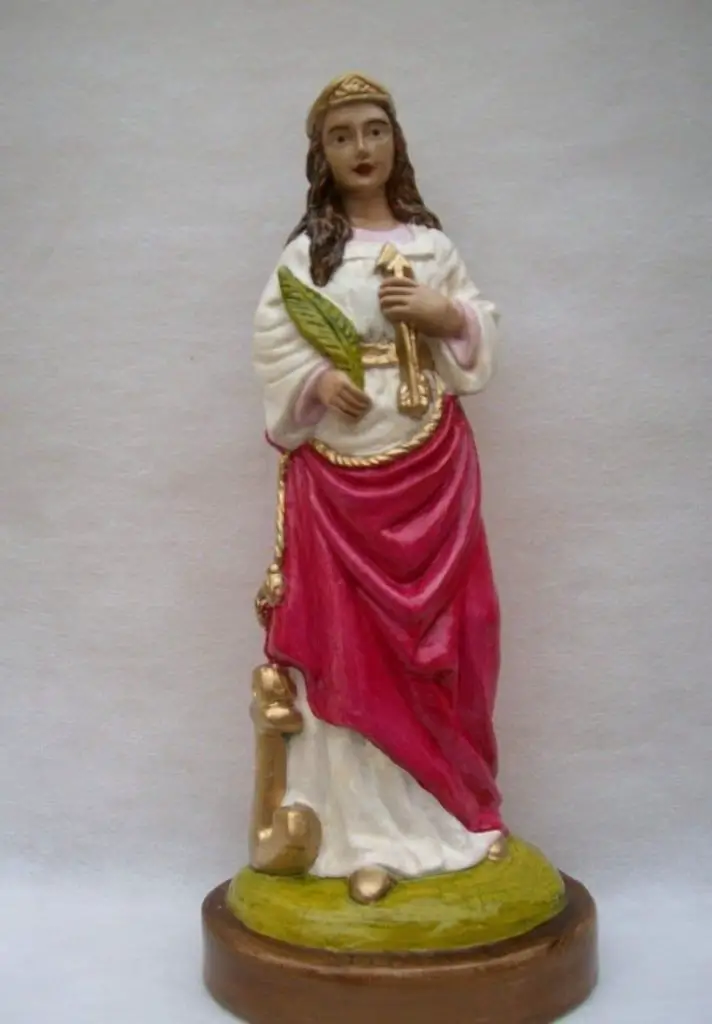
Other relevant dates for her saint’s day are 13 August, when her name is glorified; the 2nd Sunday in August is also a solemn tribute to her; 25 May commemorates the discovery of her tomb; and 29 September celebrates her arrival in the Neapolitan village of Mugnano, where her first miracle on arrival was to make rain fall in that region, which had been suffering from a long drought.
Feast of Saint Philomena
It is a tradition to celebrate the feast day of Saint Philomena every 11th August, to commemorate the eve of the triumph of her faith, despite the terrible martyrdom she suffered in the distant 4th century, and throughout the year celebrations are held in her honour, corresponding to the key dates in her history, commemorating her birth, the discovery of her crypt, her revelations and the days of her miracles.
The feast day of Saint Philomena also corresponds to the date of 30 January, when Pope Gregory proclaimed her a saint worthy of public veneration. Although she was removed from the martyrology in 1969, the hundreds of devotees of this saint have meant that her cult has grown over the years. She is also known as the thaumaturgical saint, because of the favours she grants to those who pray to her with faith, which is why her feasts are becoming more frequent.
What is Saint Philomena for?
The life of Saint Philomena, although short, is an example of how faith in God comes before everything else in this world, that is, how the fulfilment of the first commandment, to love God above all, is a promise in which God reserves for us eternal life in heaven, if we do not deny Him and follow the dictates of the Scriptures; Saint Philomena, thanks to her faith, won a privileged place in heaven. (See the article on God’s promises).
What is Saint Philomena for? In answer to this question we can say that, apart from the example she gave us of the triumph of faith over evil, she serves us as a comfort when we are faced with difficult, desperate situations or those we consider unjust, she serves us through her miracles to obtain the healing of our illnesses, and through her intercession before God, the Virgin Mary and Jesus Christ we can obtain forgiveness for our faults.
Miracles of Saint Philomena
The birth of Saint Philomena was the result of a miracle granted to her parents: her mother, like Saint Elizabeth, considered herself sterile and was constantly performing pagan rites in order to have a child to inherit her principality. The head doctor of the house promised them that he would pray to the true God so that their worries about having a child would disappear.
After the miracle of ending their infertility, St Philomena’s parents converted to Christianity, banished pagan practices from their home and educated their only daughter in the knowledge of the Holy Scriptures, albeit to a limited extent, since Christianity was forbidden at that time. St Philomena grew up with this Christian education and was martyred for defending her faith at the early age of thirteen.
The known miracles of Saint Philomena cover all the ills that afflict mankind, and therein lies the miracle of this saint; she cures all ills, which is why, since the 19th century, she has been known as the thaumaturge, the miraculous saint, and is called Saint Philomena of Rome, in memory of the miracles that the angels performed on her when she was martyred in the Roman capital.
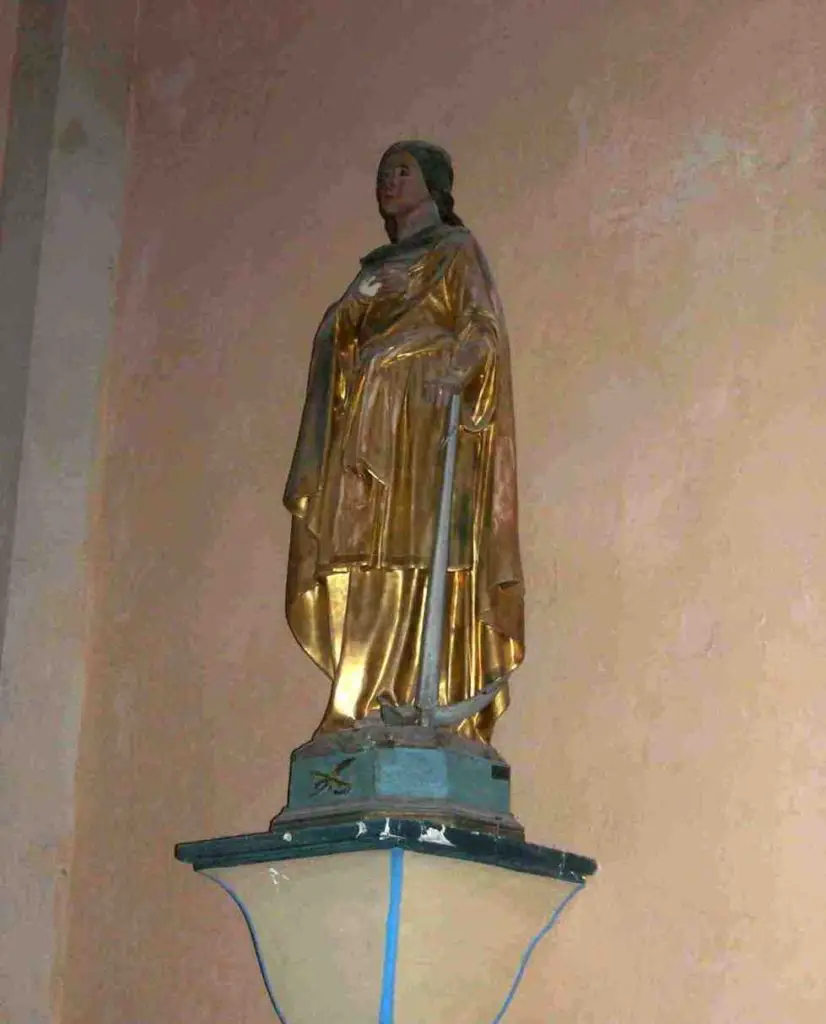
Since the beginning of the 19th century, it has been reported that her miracles have cured blindness, intestinal diseases, fever, serious illnesses, and that the oil collected near her altar in the church of Mugnano, Italy, even cures cancer. Arriving in the then village of Mugnano in September 1805, Saint Philomena brought rain that ended the drought of that year.
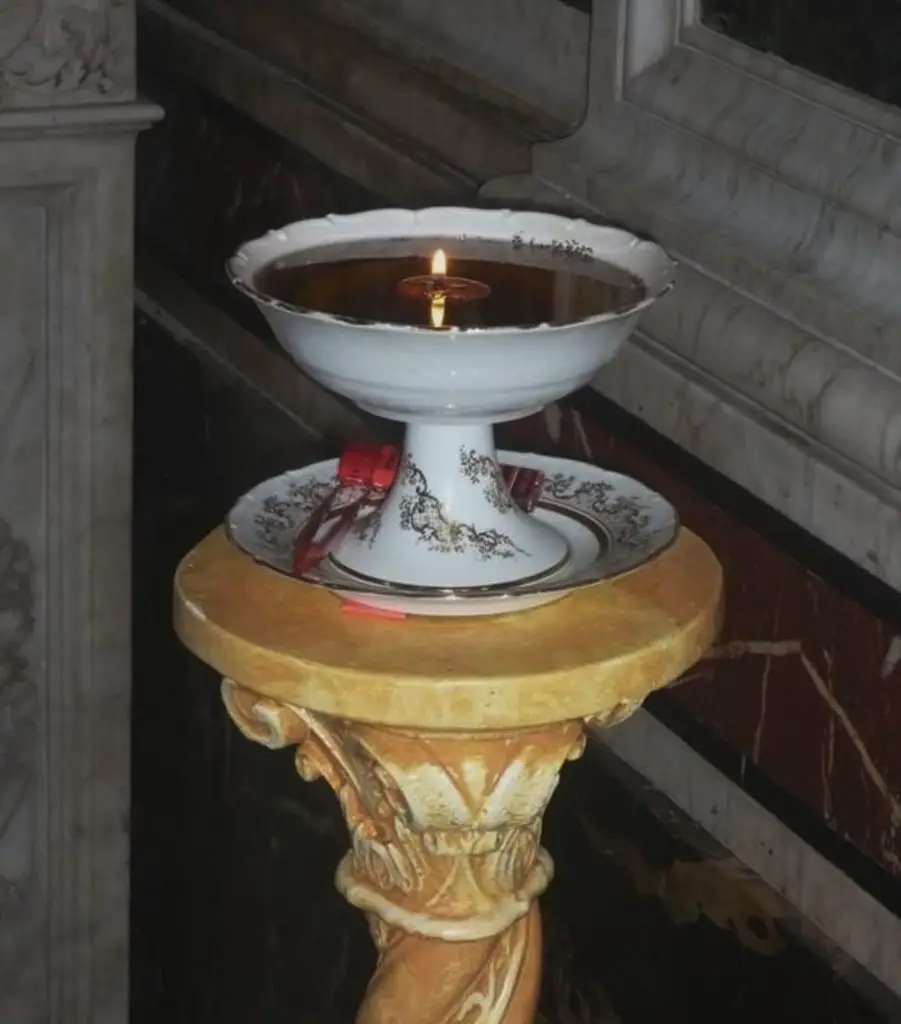
Another miracle, also different from the healing of sicknesses, was performed by Saint Philomena when the marble with which her urn was covered accidentally broke and the architect, a professional man in his trade, was unable to repair the break, but it happened, according to witnesses, that the saint’s hand was seen guiding the architect’s as he repaired the marble slab, and this succeeded in restoring all its integrity, which had been visibly broken before.
Prayer to Saint Philomena
O most glorious Virgin Mary, eternal Mother of your faithful devotees, intercede for me for the forgiveness of my sins before our universal Lord God, hear my prayers which I offer you with such humility, in which I ask you in faith to be healed of this grave illness, ________, which is plaguing my already weary humanity, and I ask you, equally full of humility, Blessed Virgin, grant me the blessing of healing. Amen.
O most holy Virgin Mary, I beg You, allow Saint Philomena, Your favourite daughter, to intervene in me with the power of the Holy Spirit to cure me of this terrible disease, _______, which is a grief that does not allow me to live, Saint Philomena, miraculous one, help me, I implore You, to stop suffering from this painful disease, ________, work in me Your mighty goodness so that this evil may cease altogether, with faith I thank You. Amen.
St Philomena Church
The relics of Saint Philomena were brought from her original tomb, discovered in 1802 in the ancient Roman cemetery of Rome, to the city of Naples, where the priest Francisco de Lucia kept them in a bookshop until they could be taken to his village of Mugnano, on the outskirts of Naples. In September 1805, the remains of St Philomena of Rome arrived in the village of Mugnano.
The priest Francisco de Lucia brought the relics of Saint Philomena with the permission of the ecclesiastical authorities in Rome, granted because the young saint was completely unknown at the time, and it was he who helped to decipher the inscriptions on the tombstone, which indicated that the crypt belonged to a Christian martyr from the early years of Christianity.
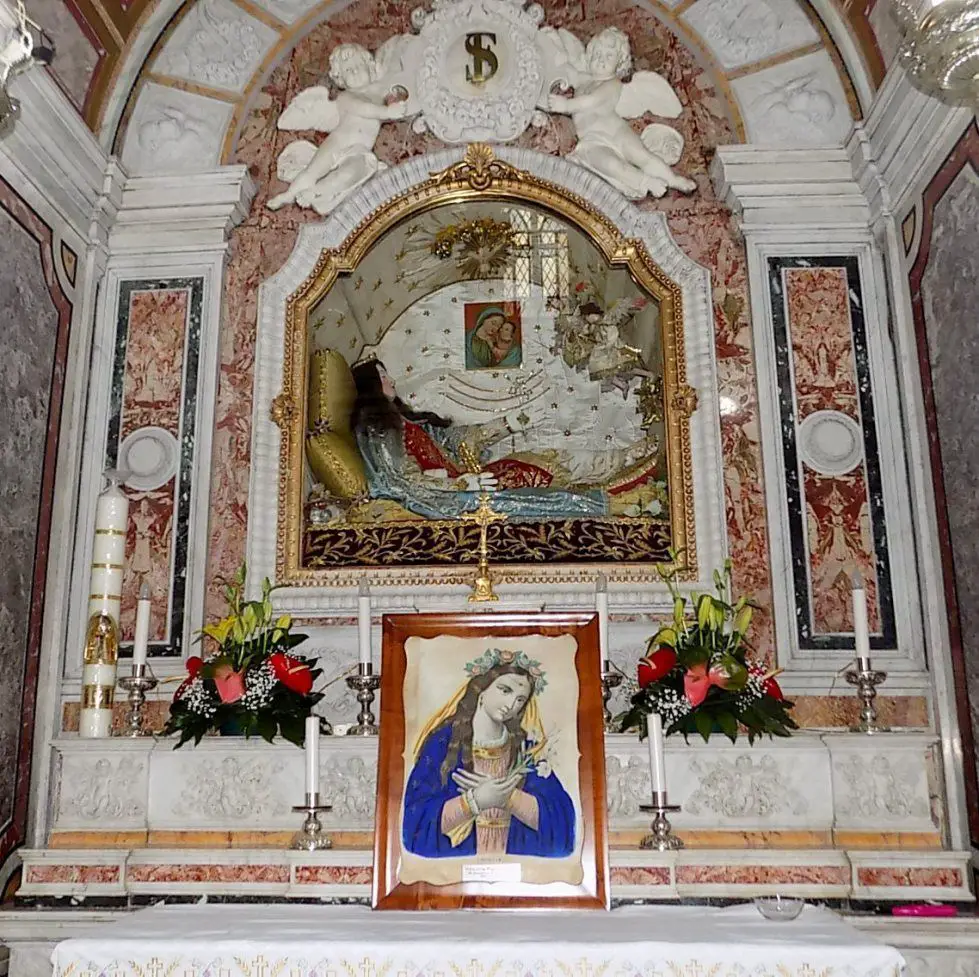
The remains were carefully placed in five boxes and taken to the church in the town of Mugnano, Italy, where they arrived in September 1805, where they have been buried ever since and where her devotion has spread throughout the world. Today Mugnano del Cardinale is an entire town belonging to the district of Avellino, and the former church is now known as the Sanctuary of Saint Philomena.
Miraculous prayer to Saint Philomena
Saint Philomena is a saint of great efficacy, who was able to cure various illnesses. If we pray to her with great faith, in this powerful prayer to Saint Philomena, we will surely obtain the favour we earnestly ask from this saint whose cult has been growing steadily since the 19th century. (See article on what prayer is).
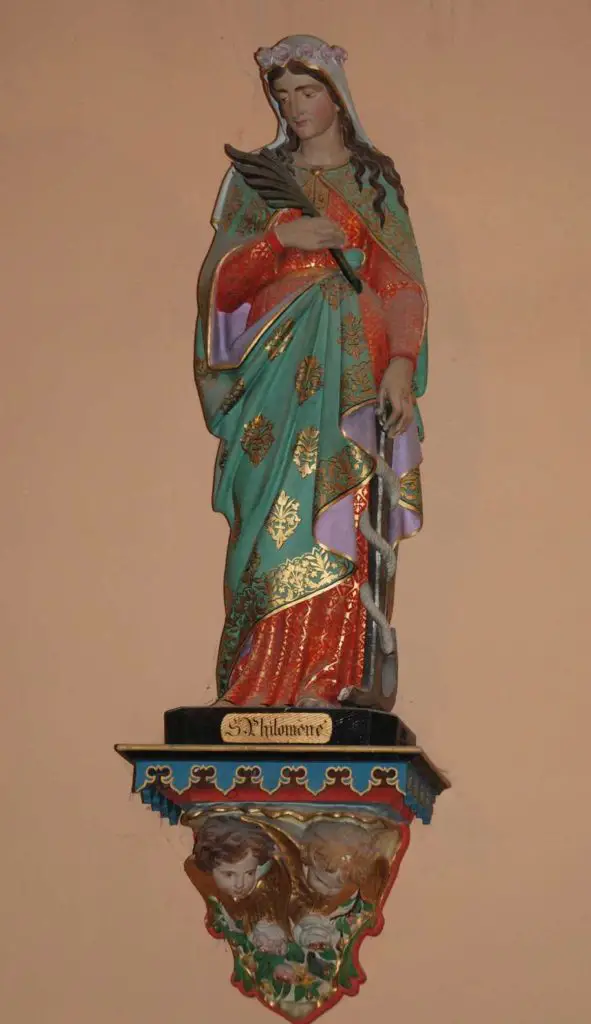
God, the only and true Lord of the universe, I humbly ask You to work Your miraculous power in me, so that all my ills may be cured, especially this illness, ________, from which I am unable to cure myself, Almighty Lord, allow Your beloved daughter, Saint Philomena, to receive my prayers, because she is a saint of my devotion, and to whom I also go in search of a speedy cure, Most High God, I thank You. Amen.
Saint Philomena, before your holy and miraculous presence, I ask you to help me to get out of this mortal situation, work in me your prodigious strength, so that with the help of Saint Gabriel the Archangel, all my ills may disappear and this suffering may flee from my body, I also ask you to intercede for me, so that God may forgive me my faults as a sinner, and I promise to follow the path of enlightenment that Jesus Christ has shown us with his Gospel. Amen.
Daily prayer to St Philomena
Oh, Saint Philomena, exalted saint, who knew how to defend your faith, I come to you humbly to ask you with all my love, today and all these days, keep me away from the bad situations in which I could unjustly fall, help me with your miraculous power, free me from my enmities, most exalted saint, drive away all despair from my side, and may faith be reborn in me every day, through God, Jesus Christ and the Virgin Mary, thank you. Amen.
Saint Philomena, young virgin, who by her unwavering faith has attained a privileged place in the heavenly heavens, give me the strength to achieve, by your mighty miracles, the goals I set myself each day, help me when I need it most, Saint Philomena, I beseech you, and intercede for my humanity before the great goodness of our Saviour Jesus Christ, that He may bless my days and forgive this sinner, I thank you. Amen.
Novena to Saint Philomena
Saint Philomena is a saint who, since the 19th century, has worked numerous miracles, to her we direct our prayers, we pray the Rosary of Saint Philomena, and to her we go in search of consolation or miraculous help to heal our ills, she is very effective in curing diseases; therefore, a novena, which is a complete solemnity, is considered effective to obtain her intervention to have peace and solution to our ills.
Hymn to Saint Philomena
Saint Philomena is one of the saints that attracts more and more devotees all over the world, before her great miraculous power we go because we know of the many miracles that she is able to perform, her only consoling power moves us to dedicate our prayers to her, in search of peace for our worries, in search of relief for our ailments, for this reason it is remarkable to dedicate a rosary to Saint Philomena or a song, as the following video.
Patronage of the Church of Saint Philomena
The Patronage of the Sanctuary of St. Philomena has ecclesiastical jurisdiction over the town of Mugnano, the Living Rosary and the Foundation of the Protectors of the Children of Mary, the Archconfraternity of St. Philomena, the Confraternity of St. Philomena, the Institutions that promote the life and miracles of St. Philomena in their localities and throughout the world.

The remains of Saint Philomena have been kept there since 1805, and it is the religious centre that has spread the cult of this saint the most. Other churches have also been built under the patronage of Saint Philomena, such as the Church of Saint Philomena Santiago in Chile, the Cathedral of Saint Philomena in Mysore, India, and the Temple of Saint Pius X in Mexico, where there is a chapel dedicated to Saint Philomena.
Church of St Philomena in Monterrey
The church of Santa Filomena in the city of Monterrey, Mexico, is a simple and beautiful church dedicated to this saint, it is representative of the promotion of Santa Filomena in Mexico, although its activities are local, such as masses, prayers and patronal fiestas in honour of Santa Filomena, it has the peculiarity of having, without indicating the date, manner or place of acquisition, very small parts of the relics of Santa Filomena.
These relics are a lock of hair and a piece of cloth belonging to Saint Philomena, which have helped to strengthen the devotion to the miracle-working saint, and are displayed in a special container, visible to all visitors, to whom she has granted many miracles.
The temple of Saint Philomena in Guadalajara
The Temple of Pope Pius X, located in Guadalajara, Morelos, Mexico, is a temple of Byzantine style, it is located near the station Nº 11 of the light train of Guadalajara, called, Santa Filomena Station.
In the temple of Saint Pius X there is a chapel dedicated to Saint Philomena, which has become very popular, as it is frequently visited by the faithful of this city and other surrounding localities, which has led to the temple of Saint Pius X being named the temple of Saint Philomena.

